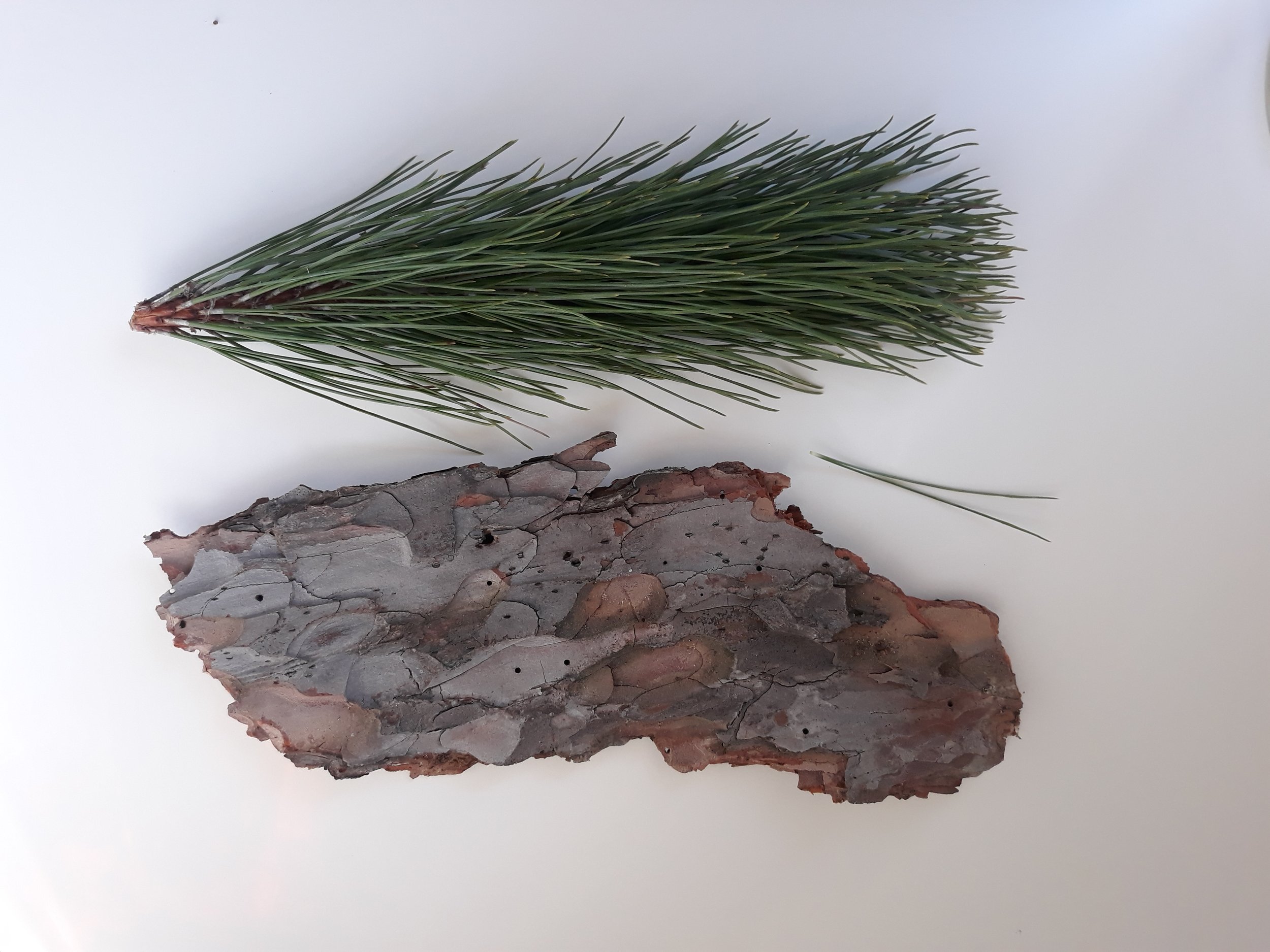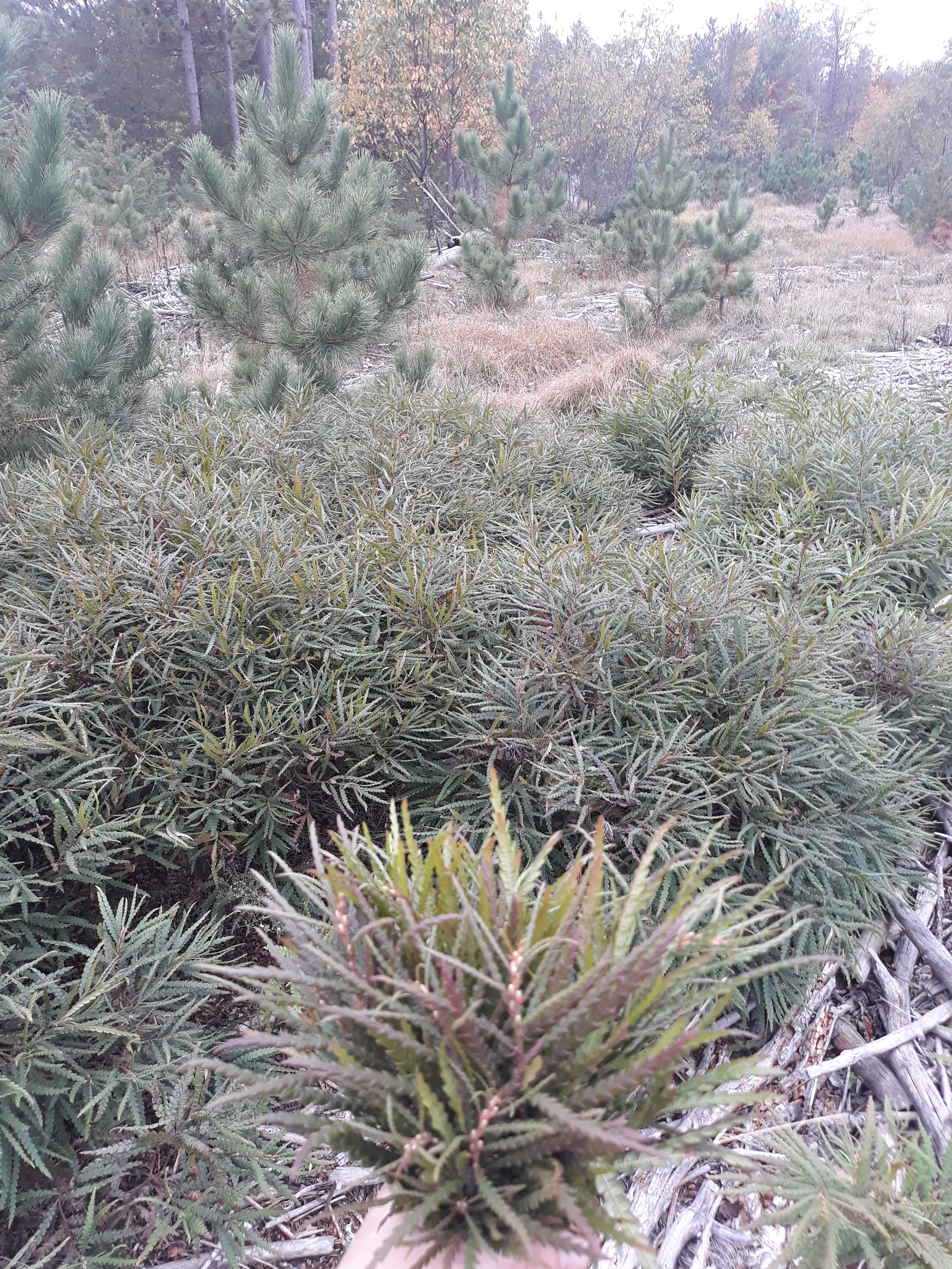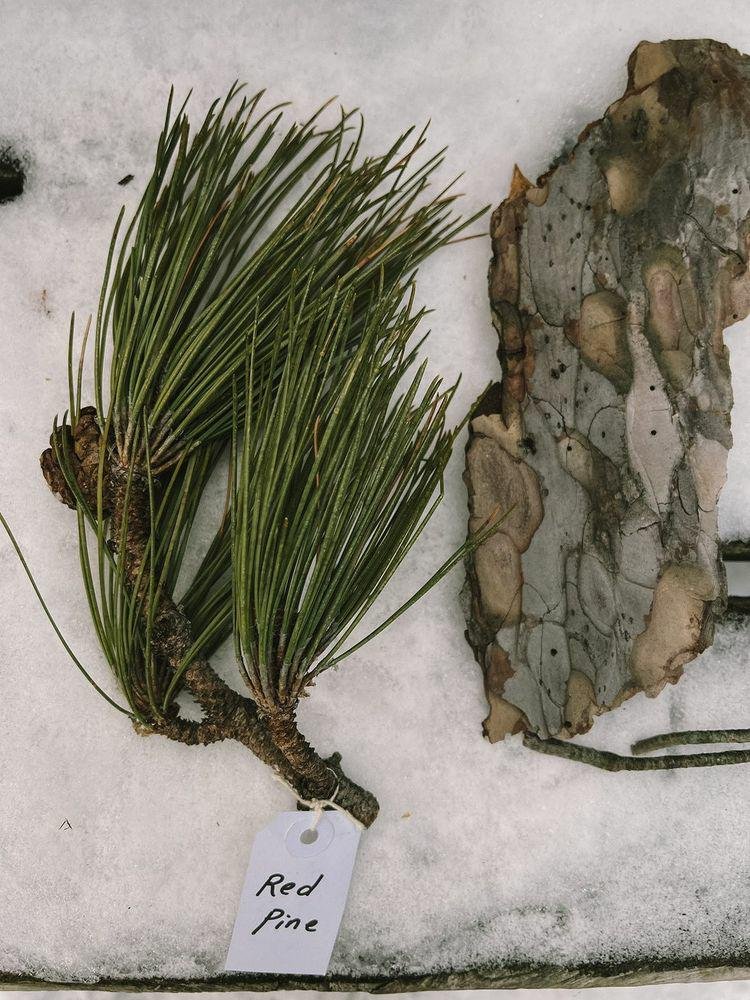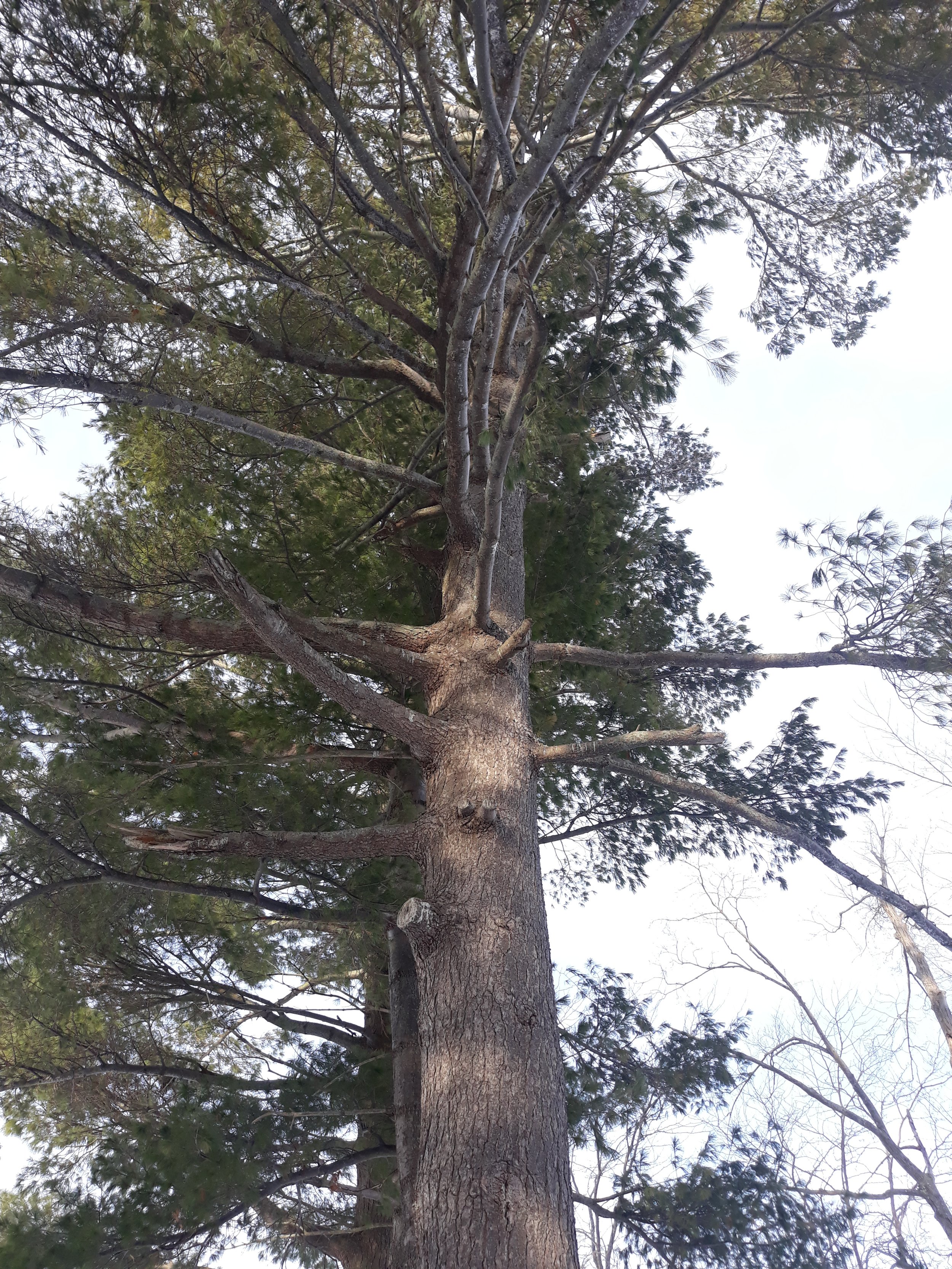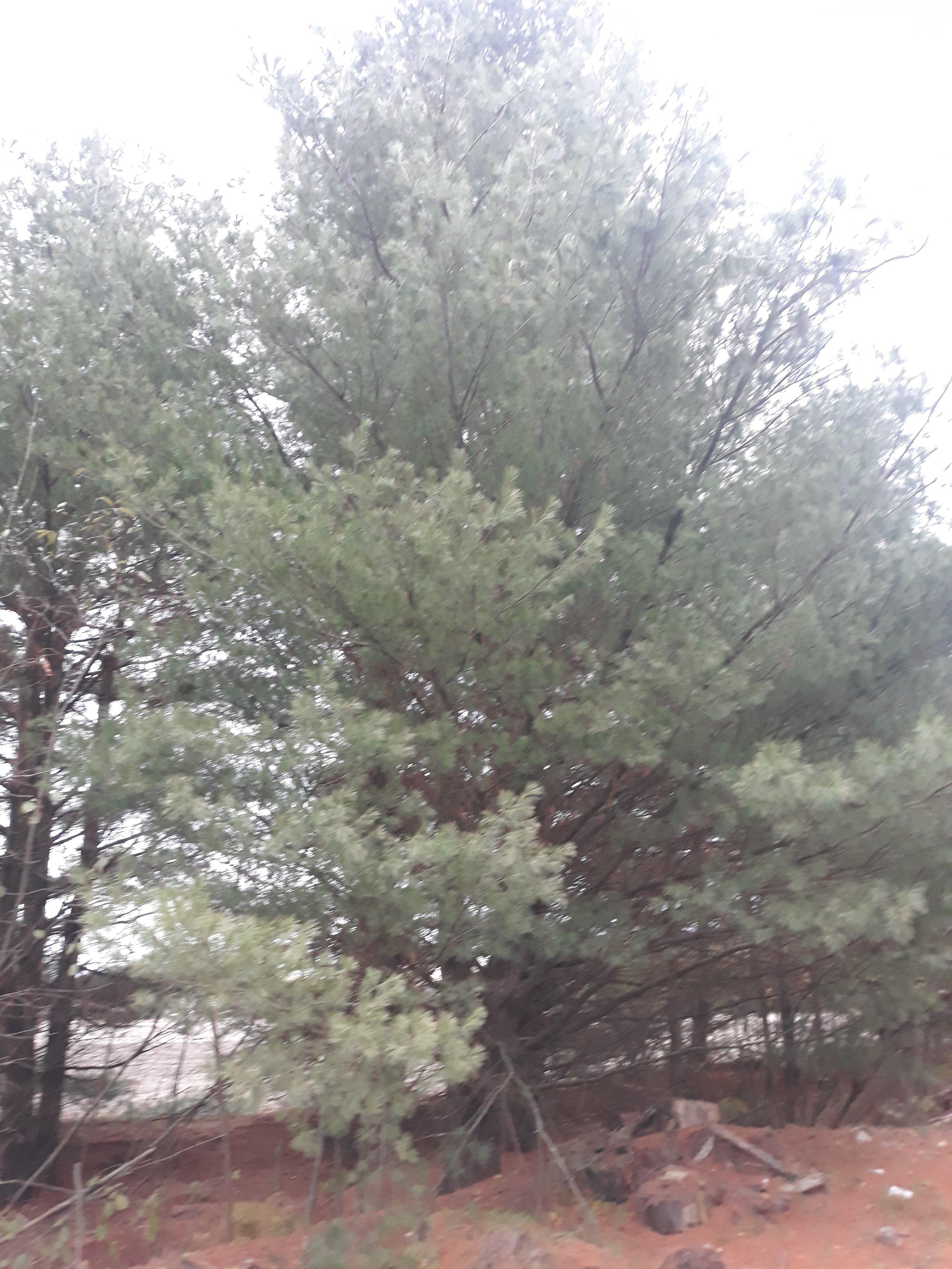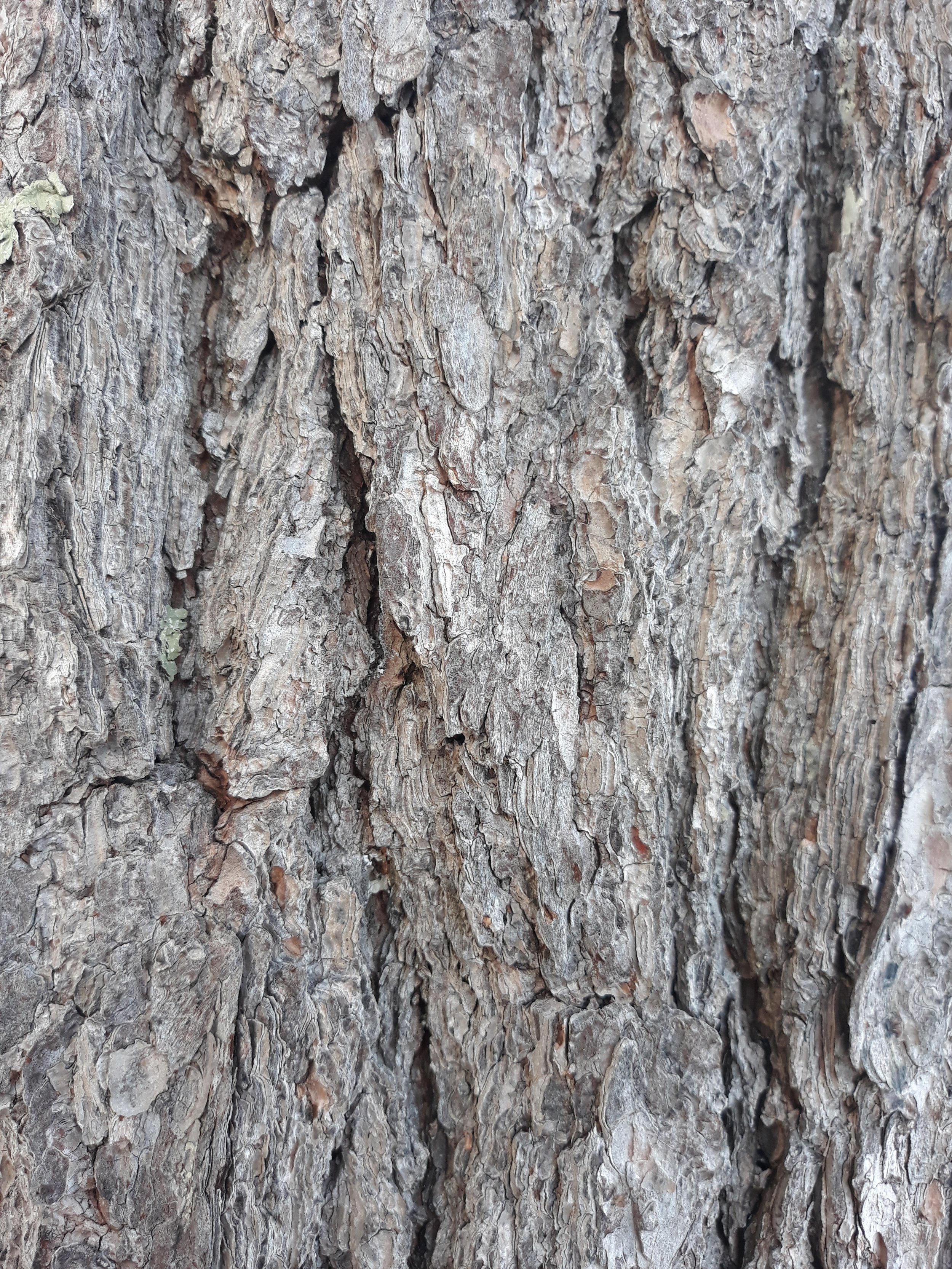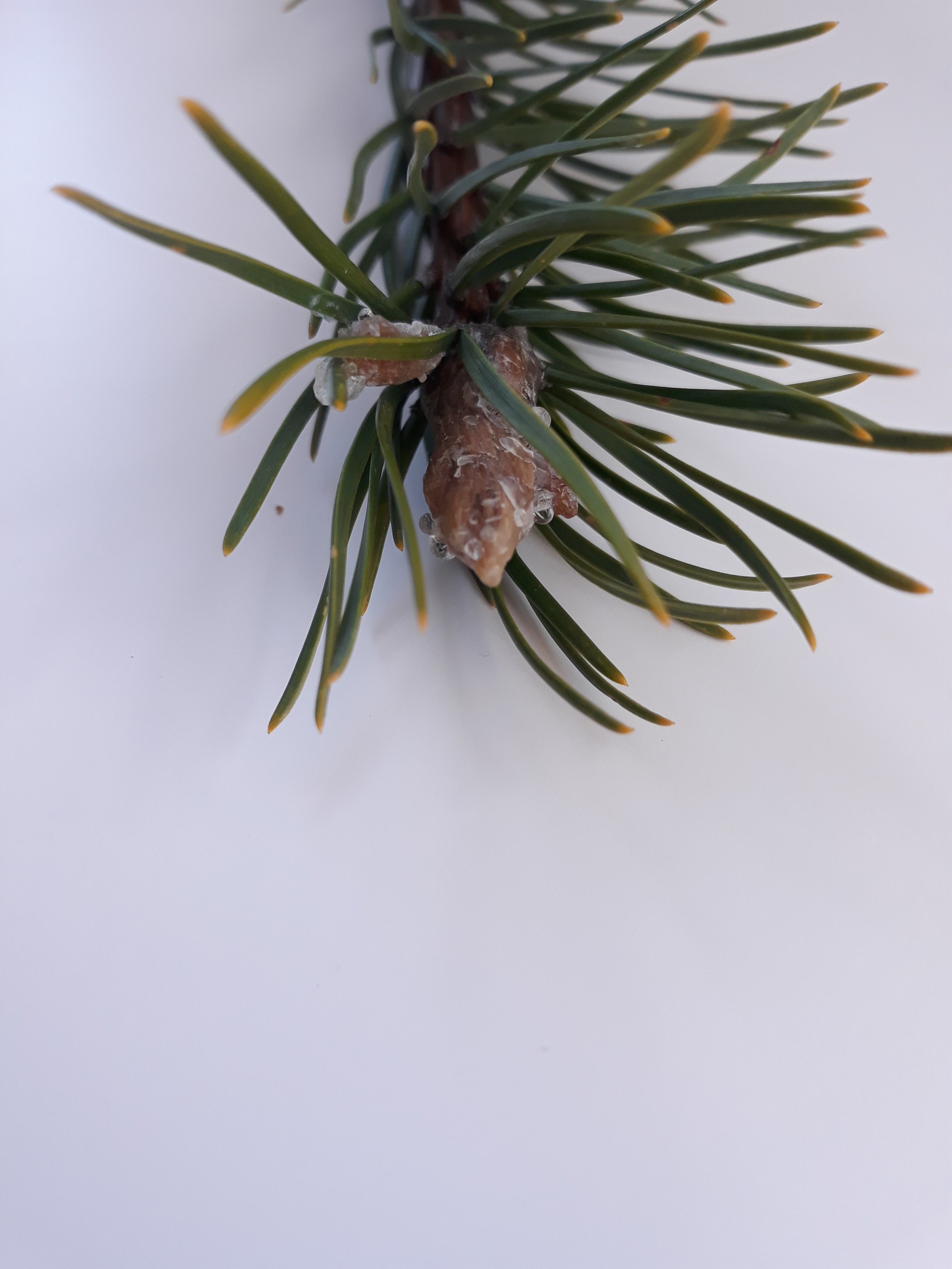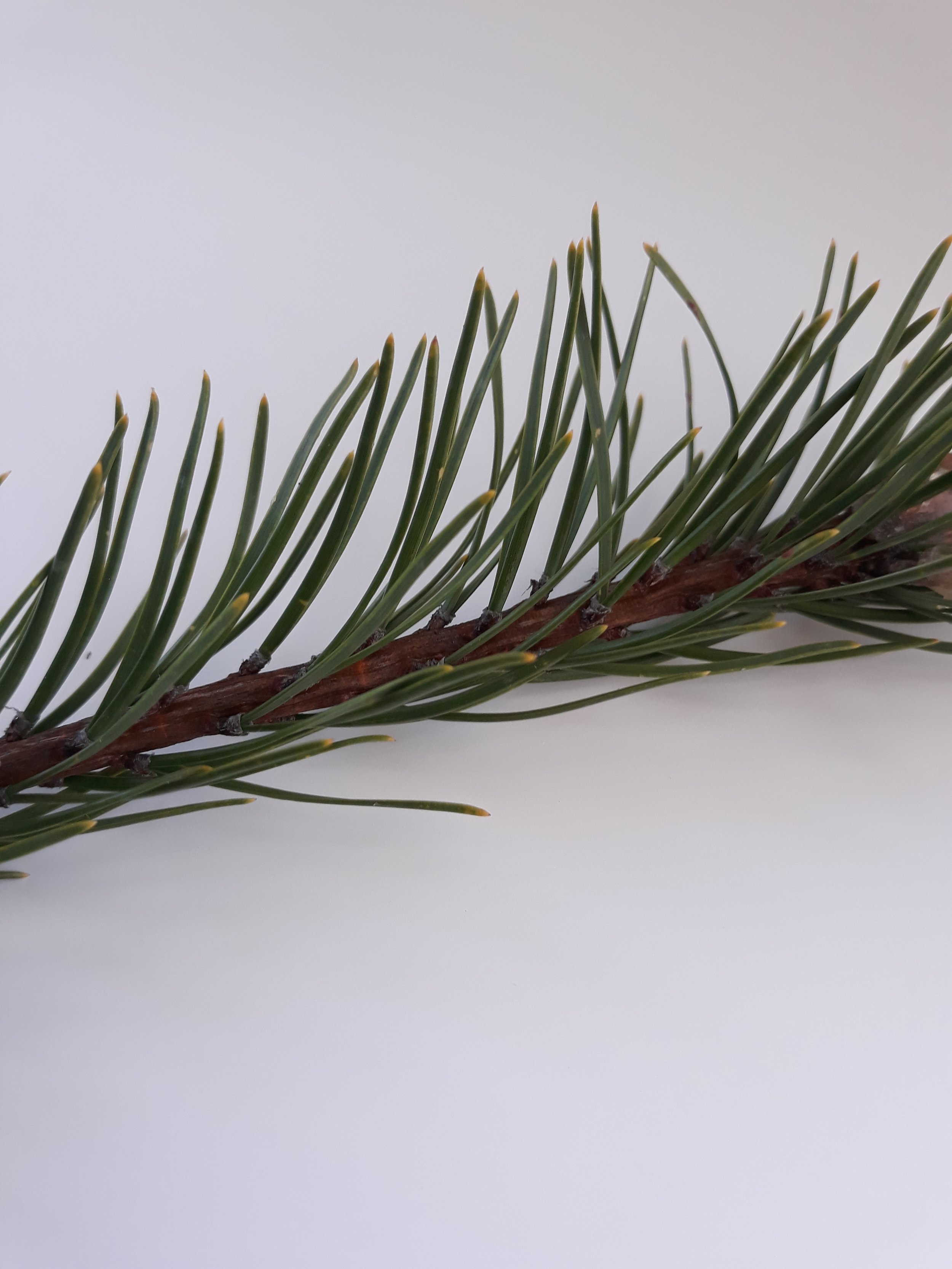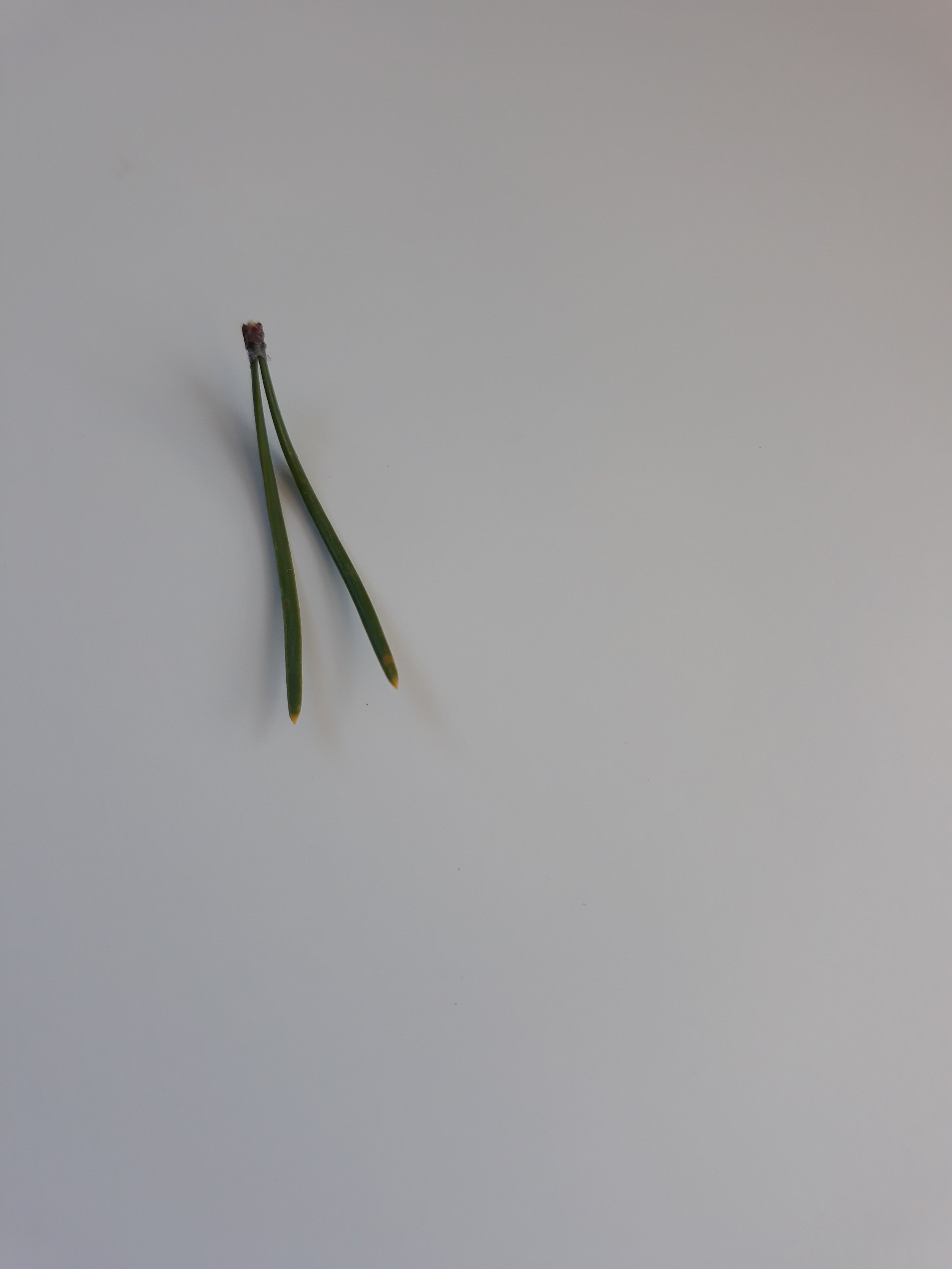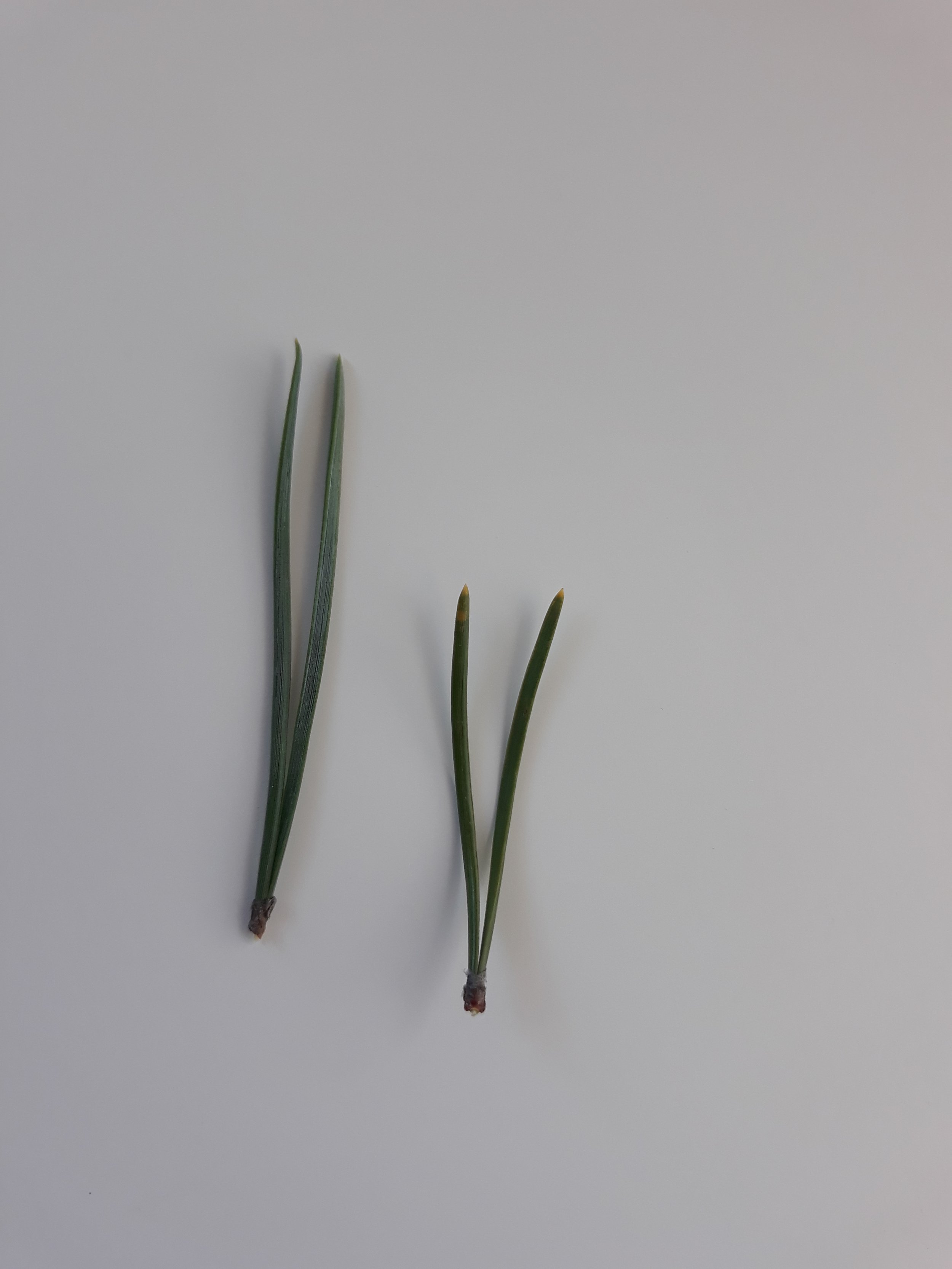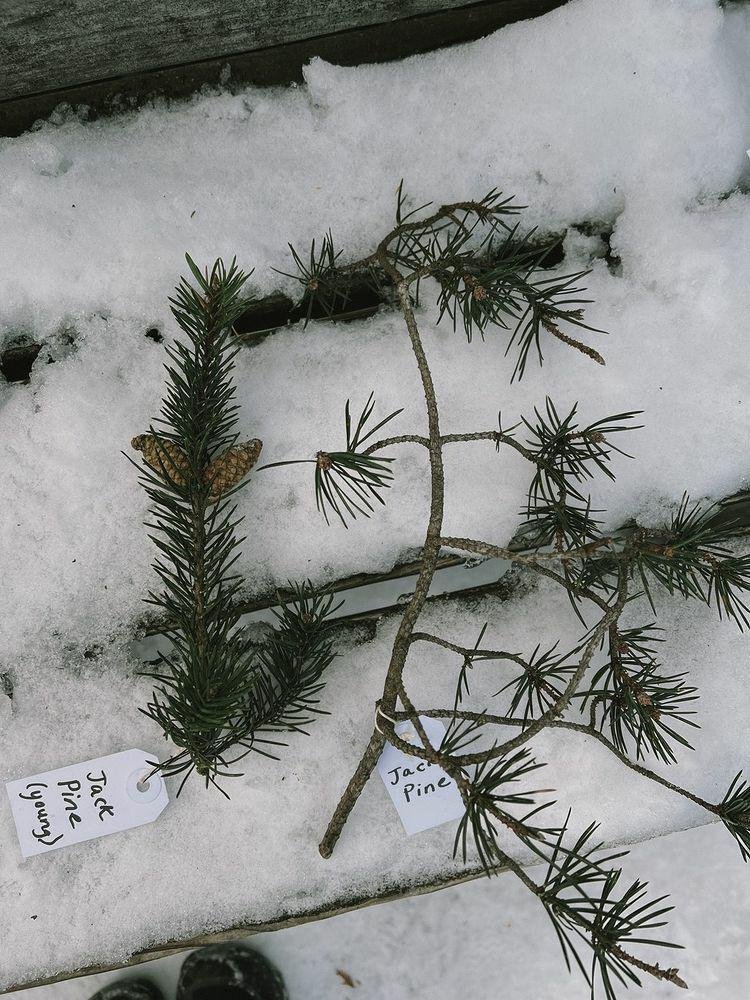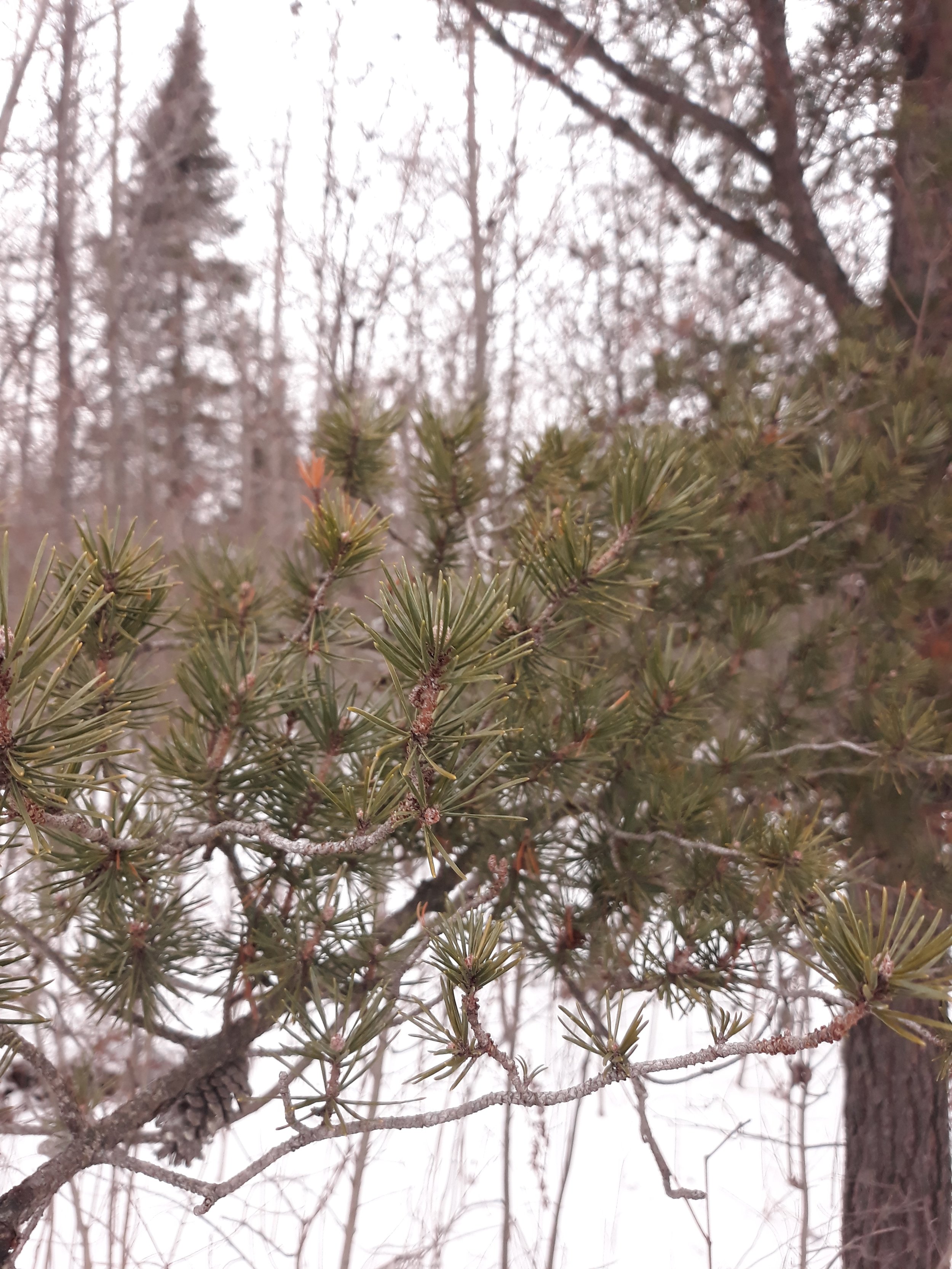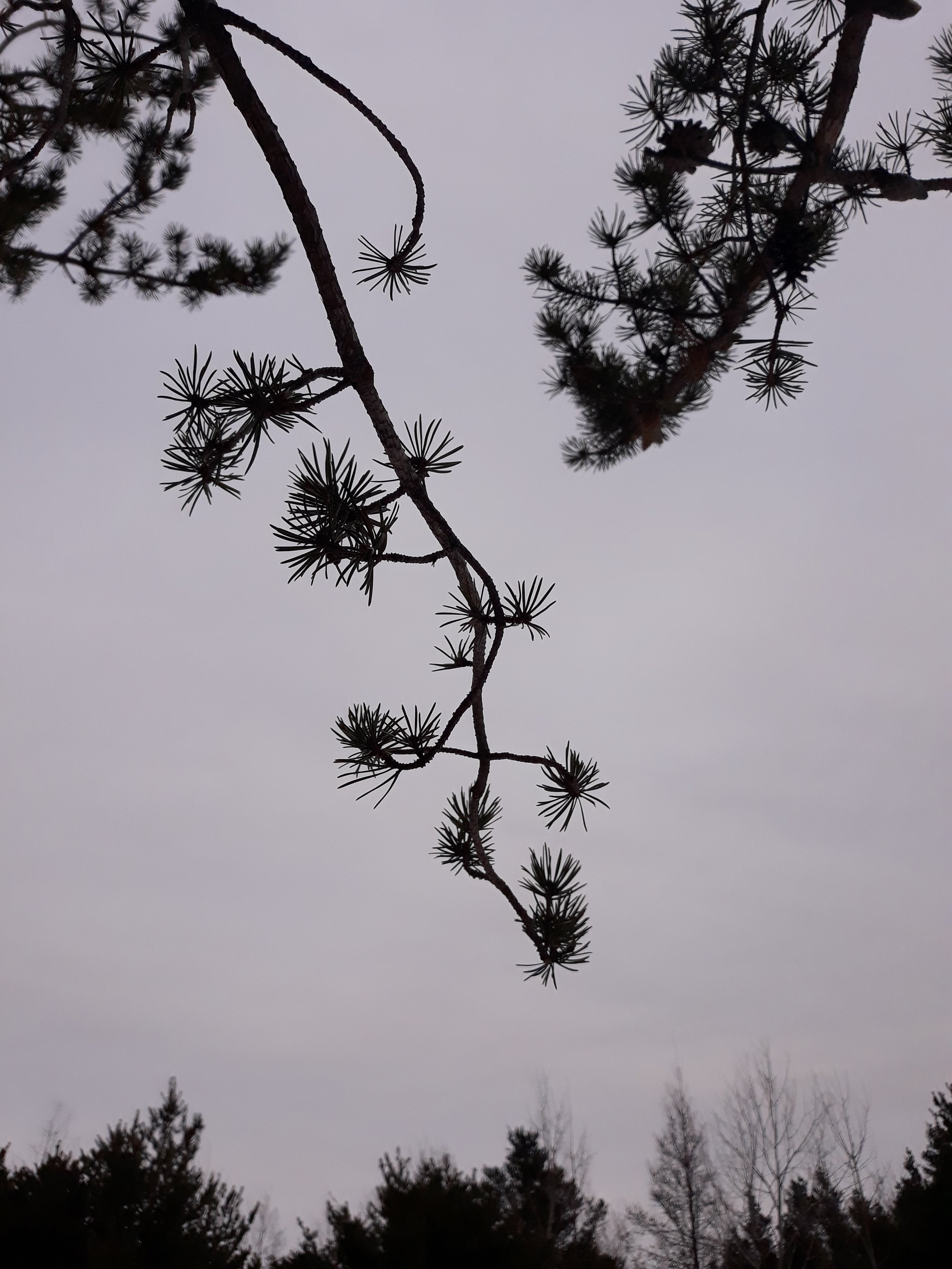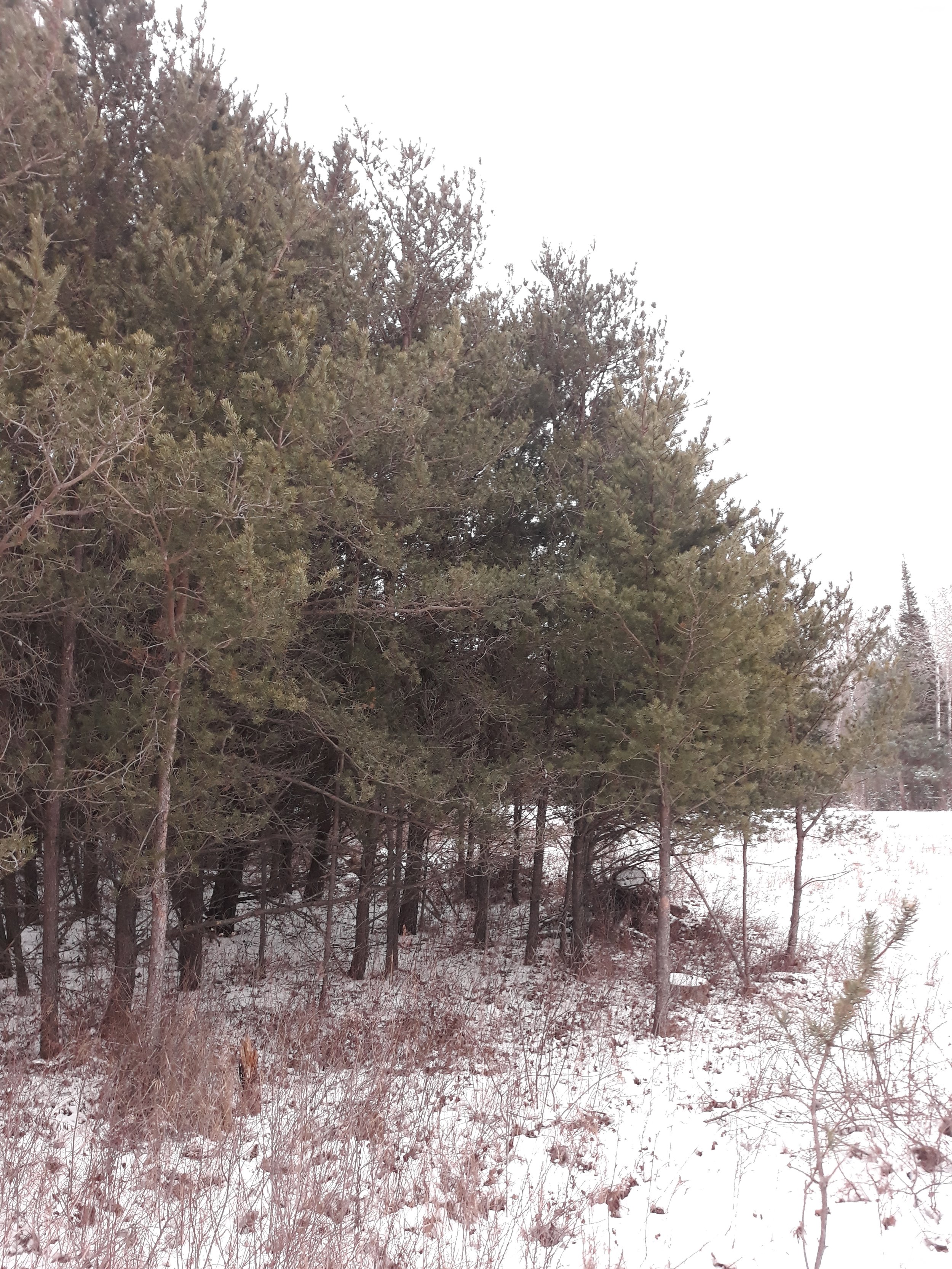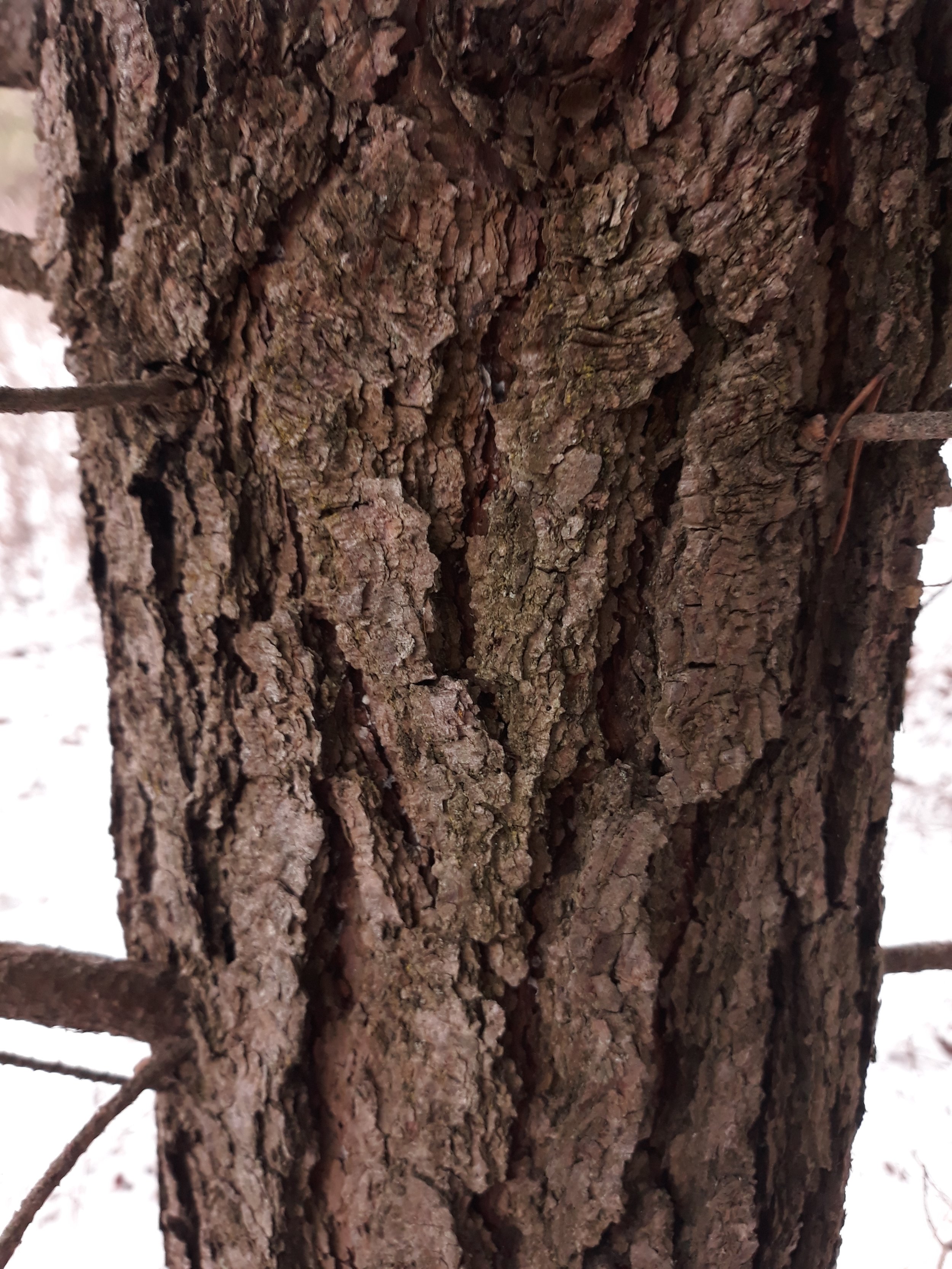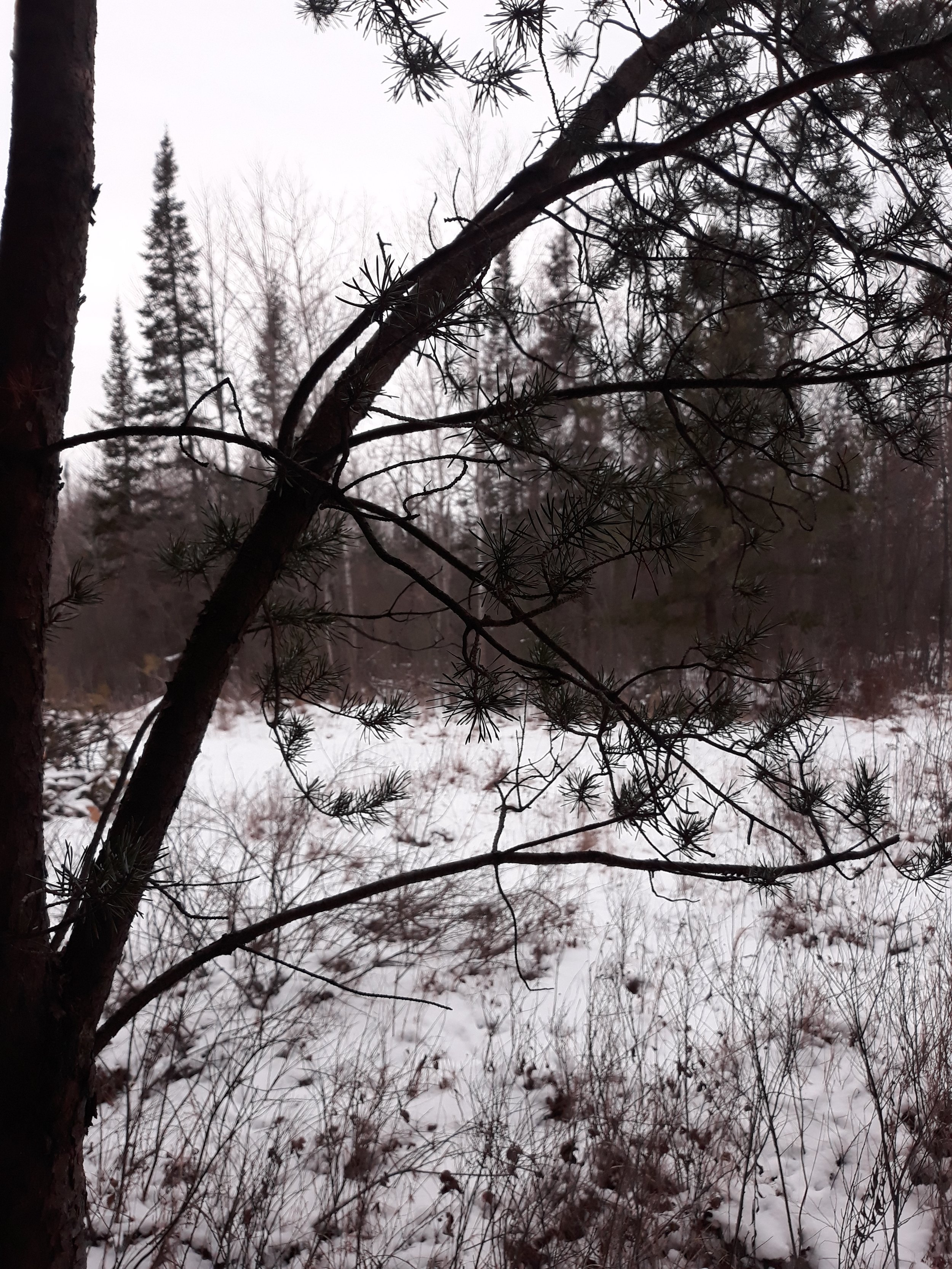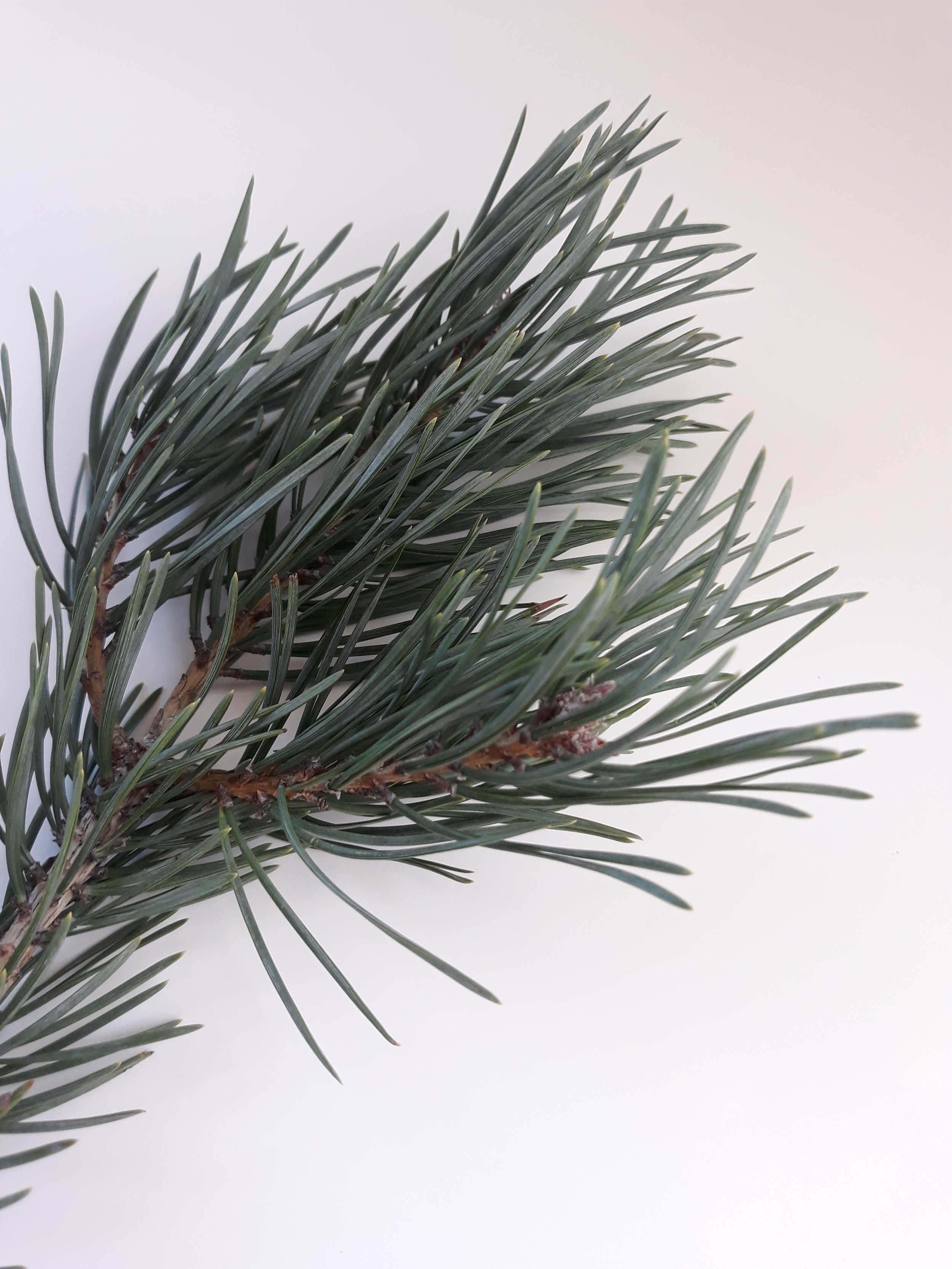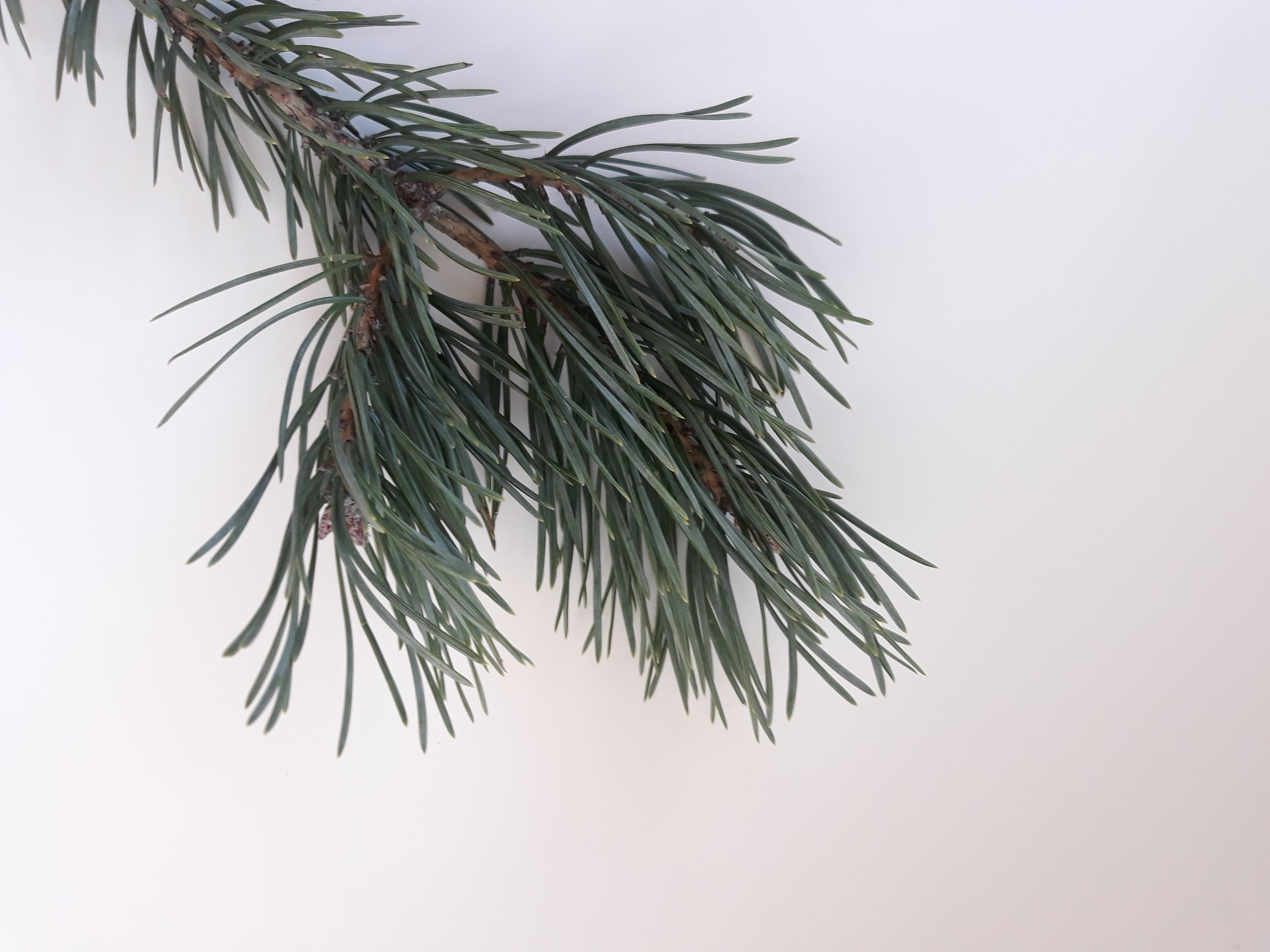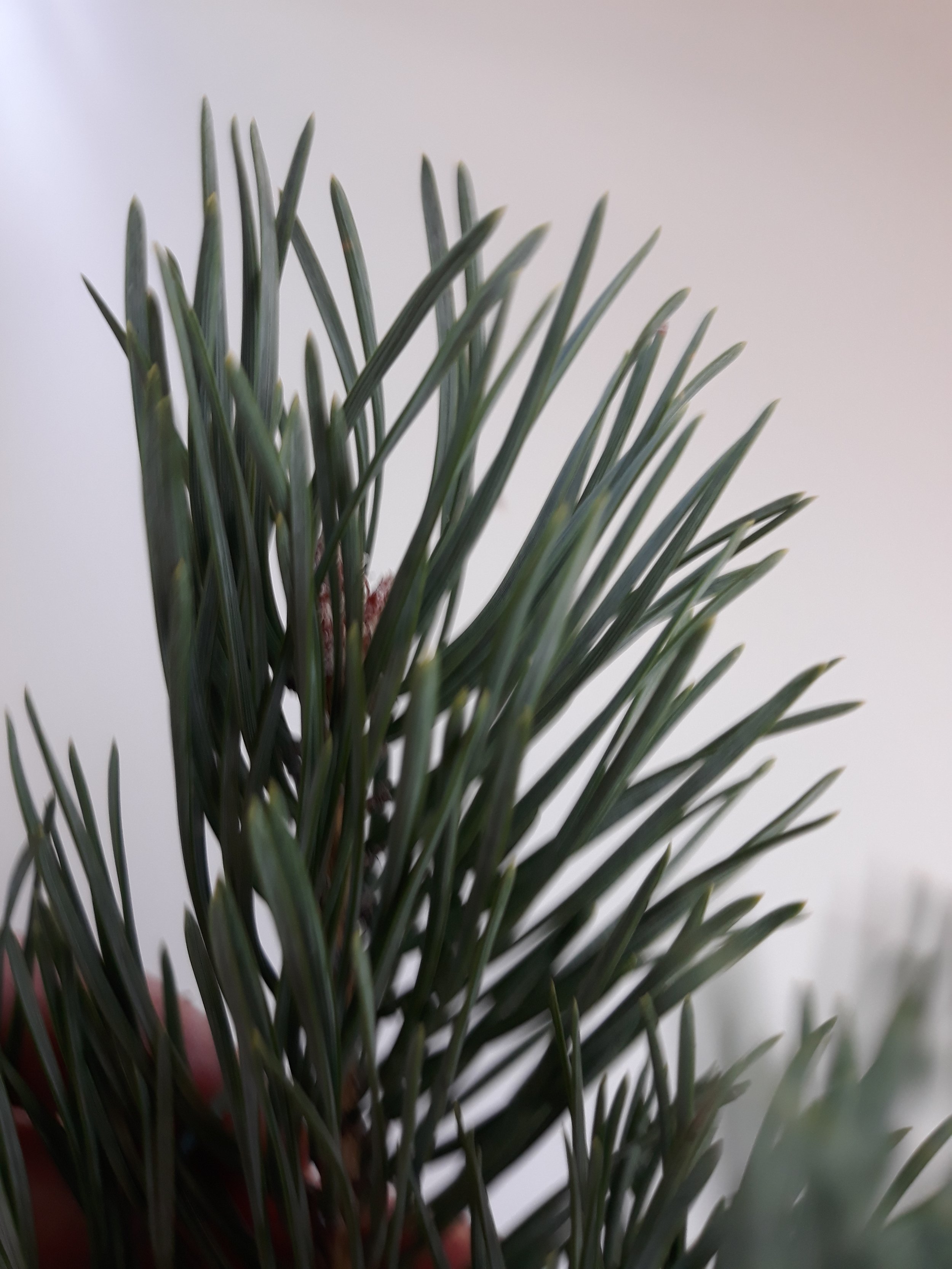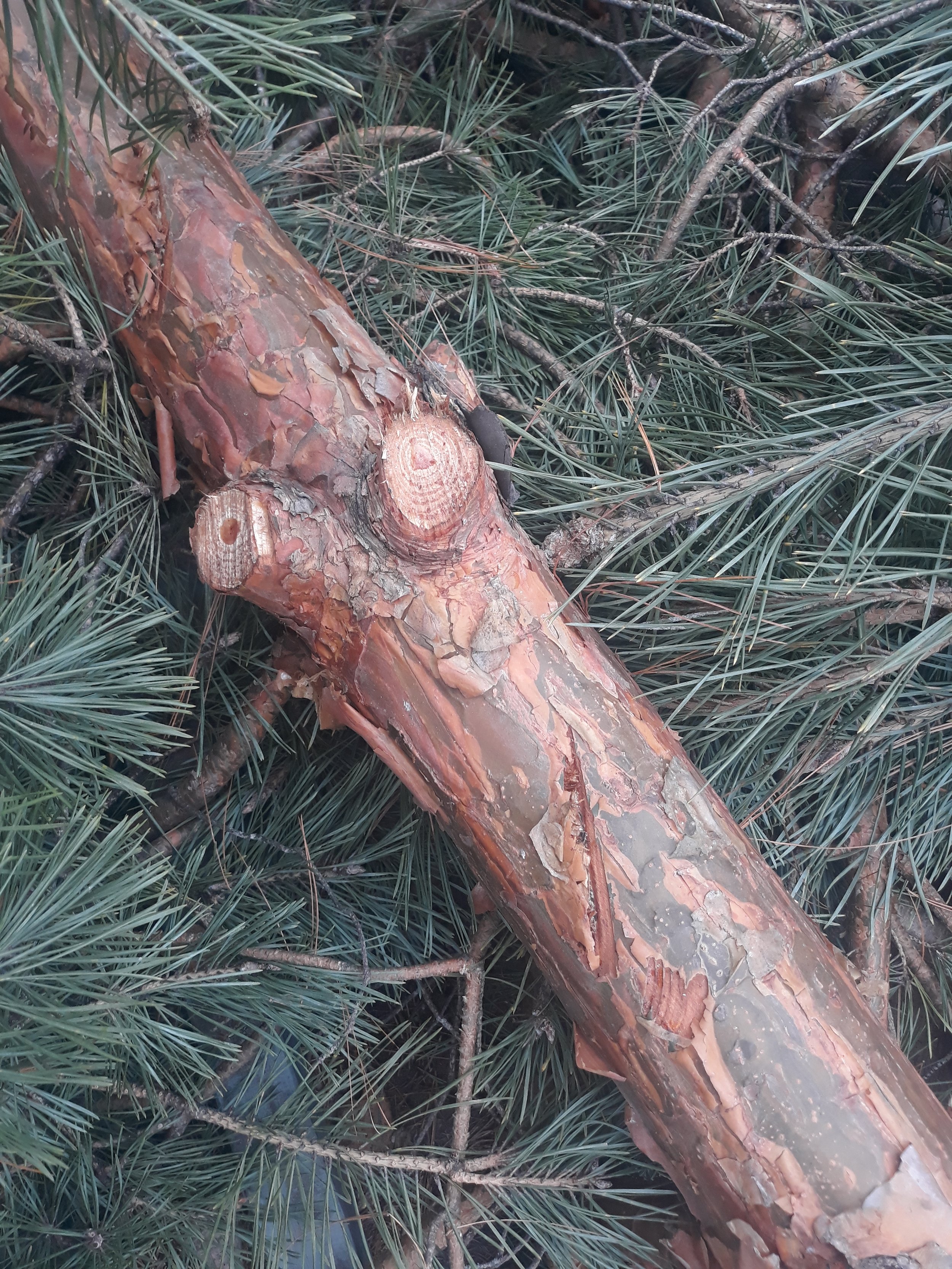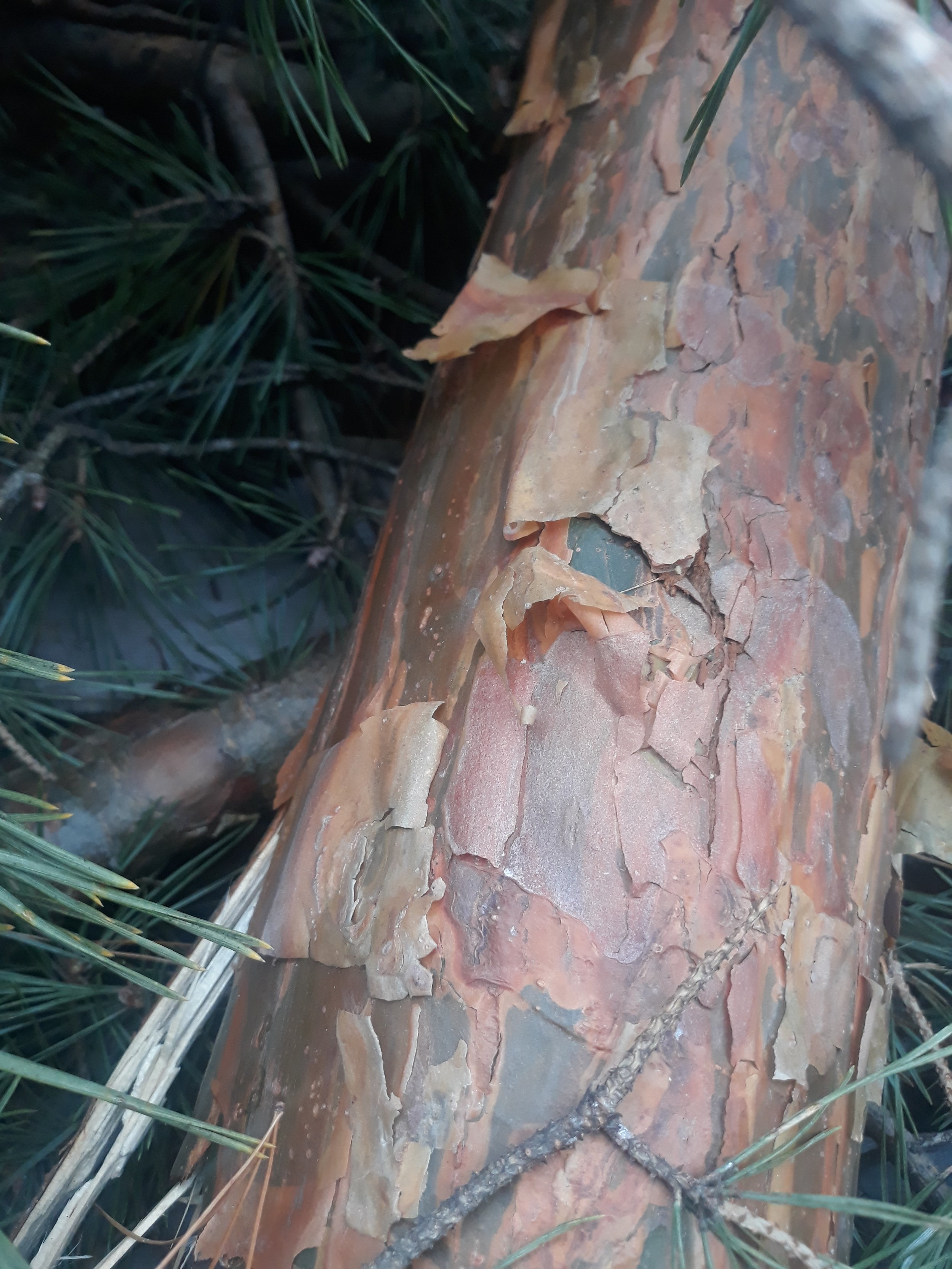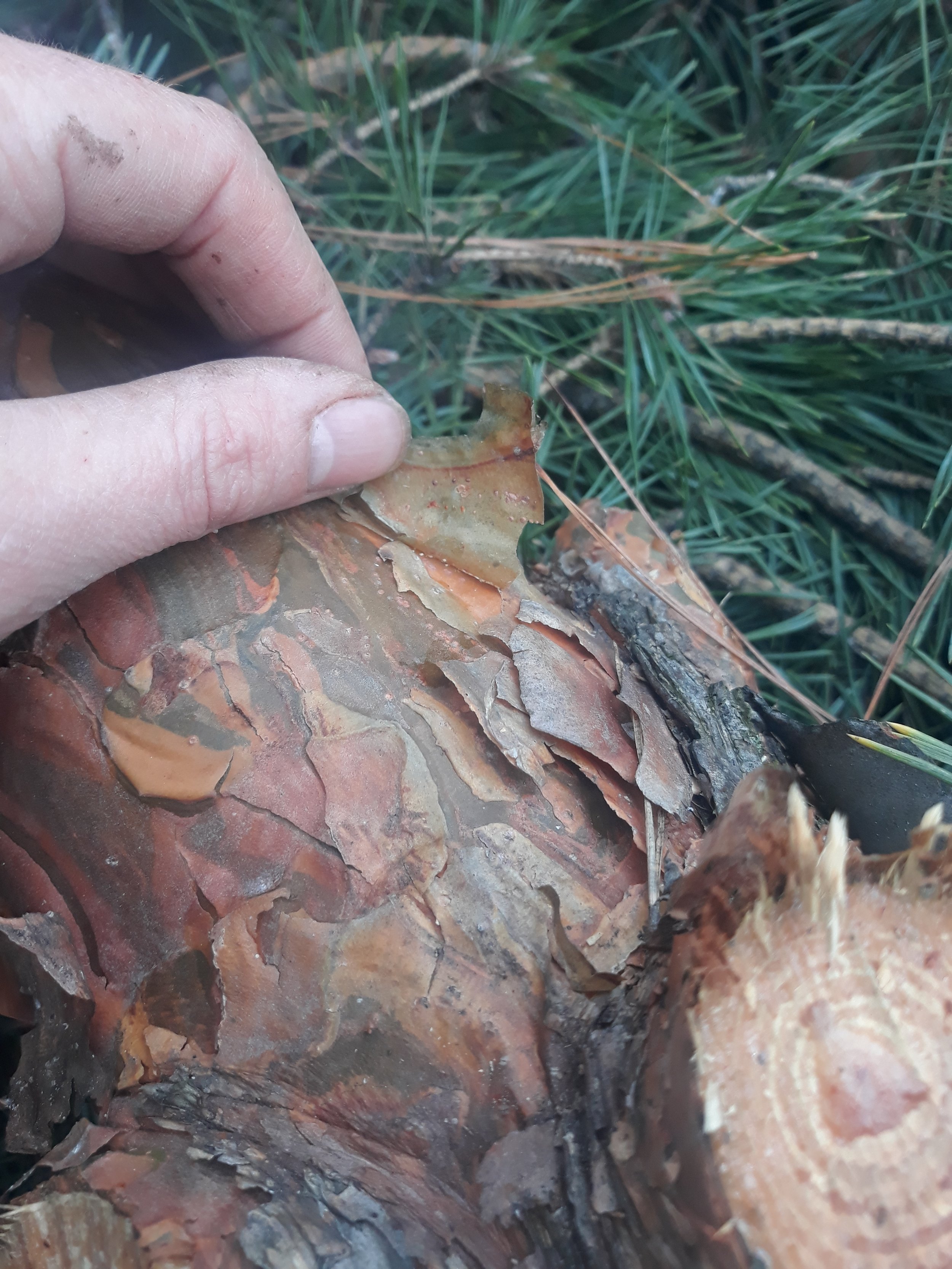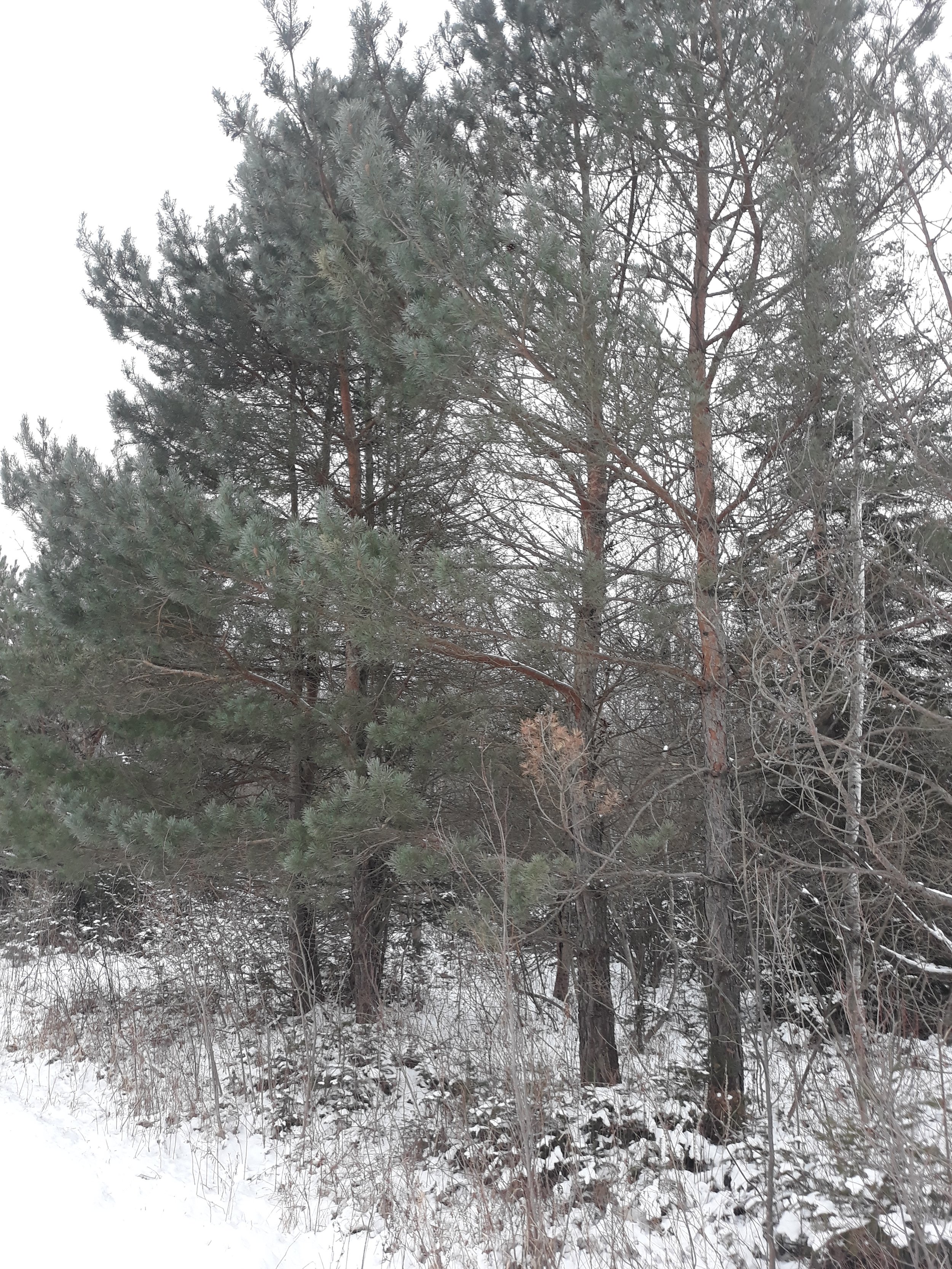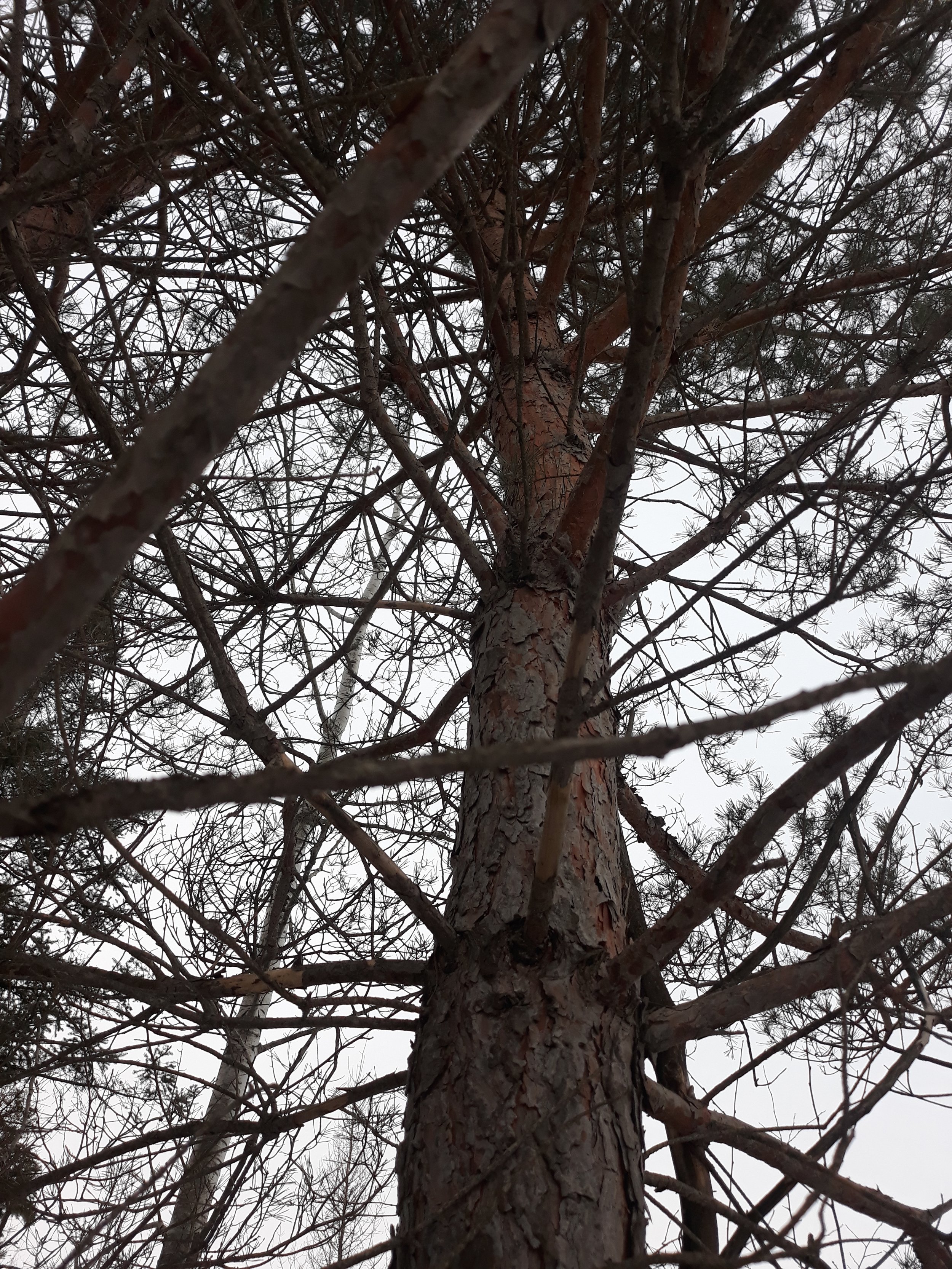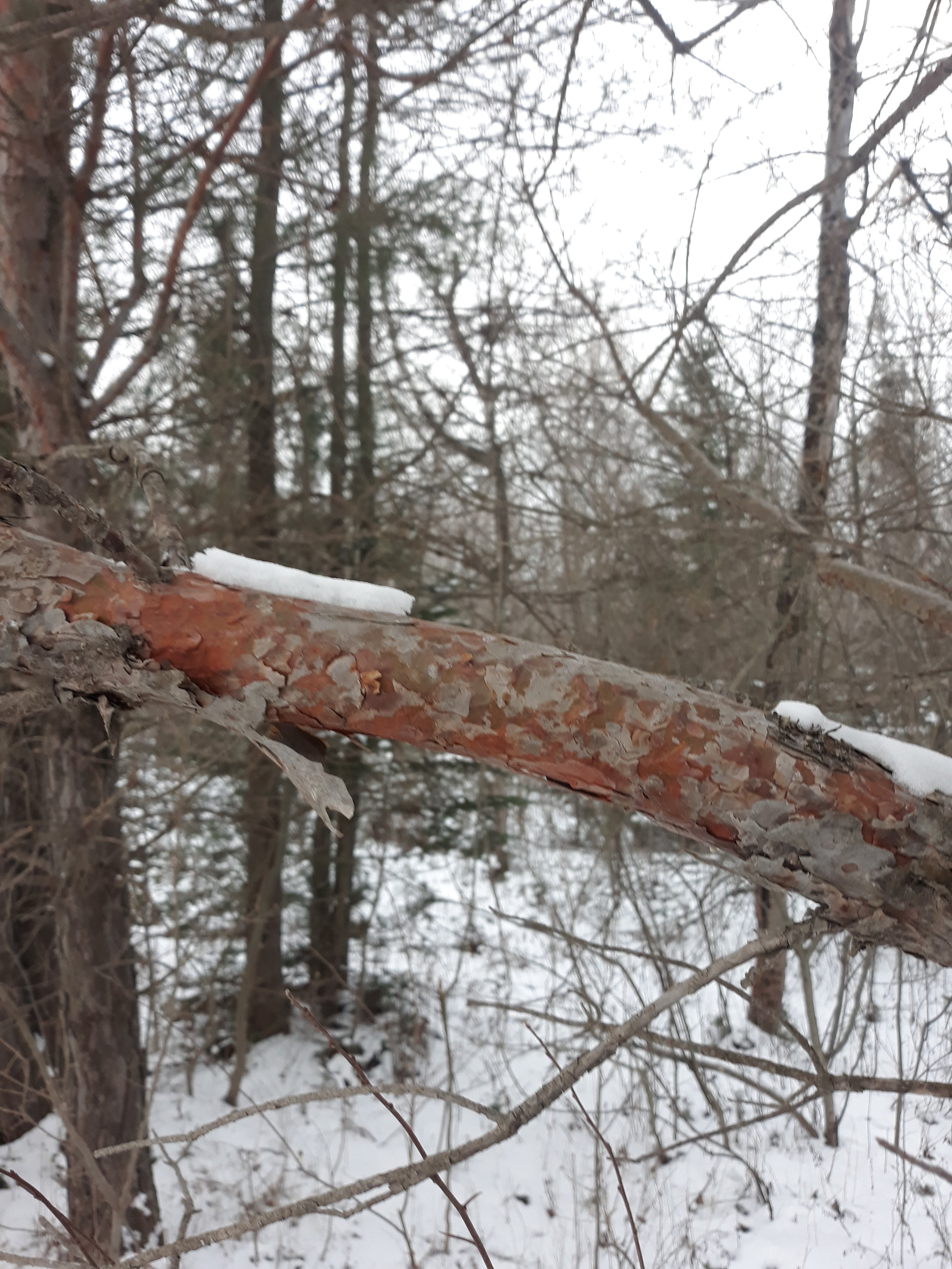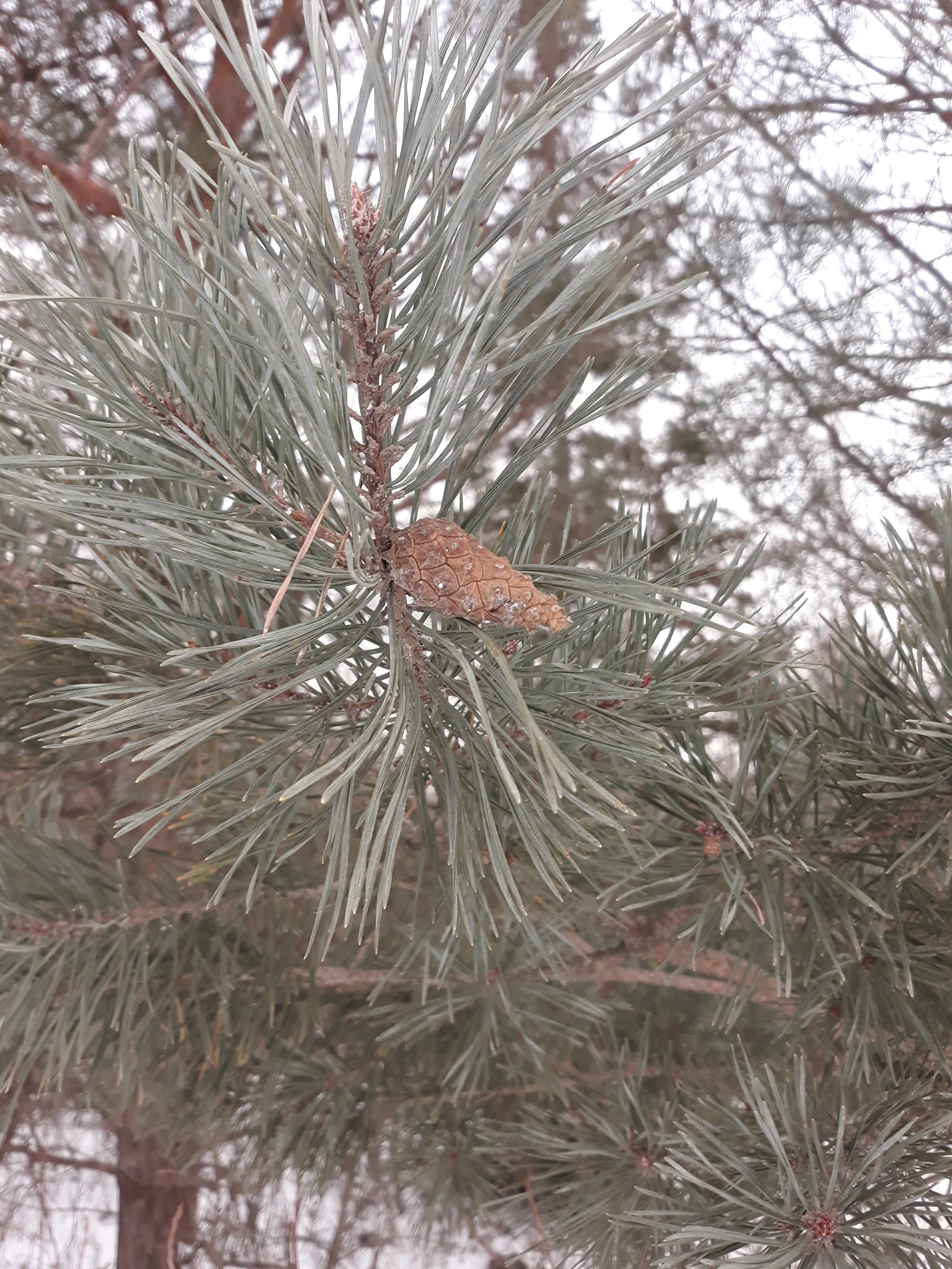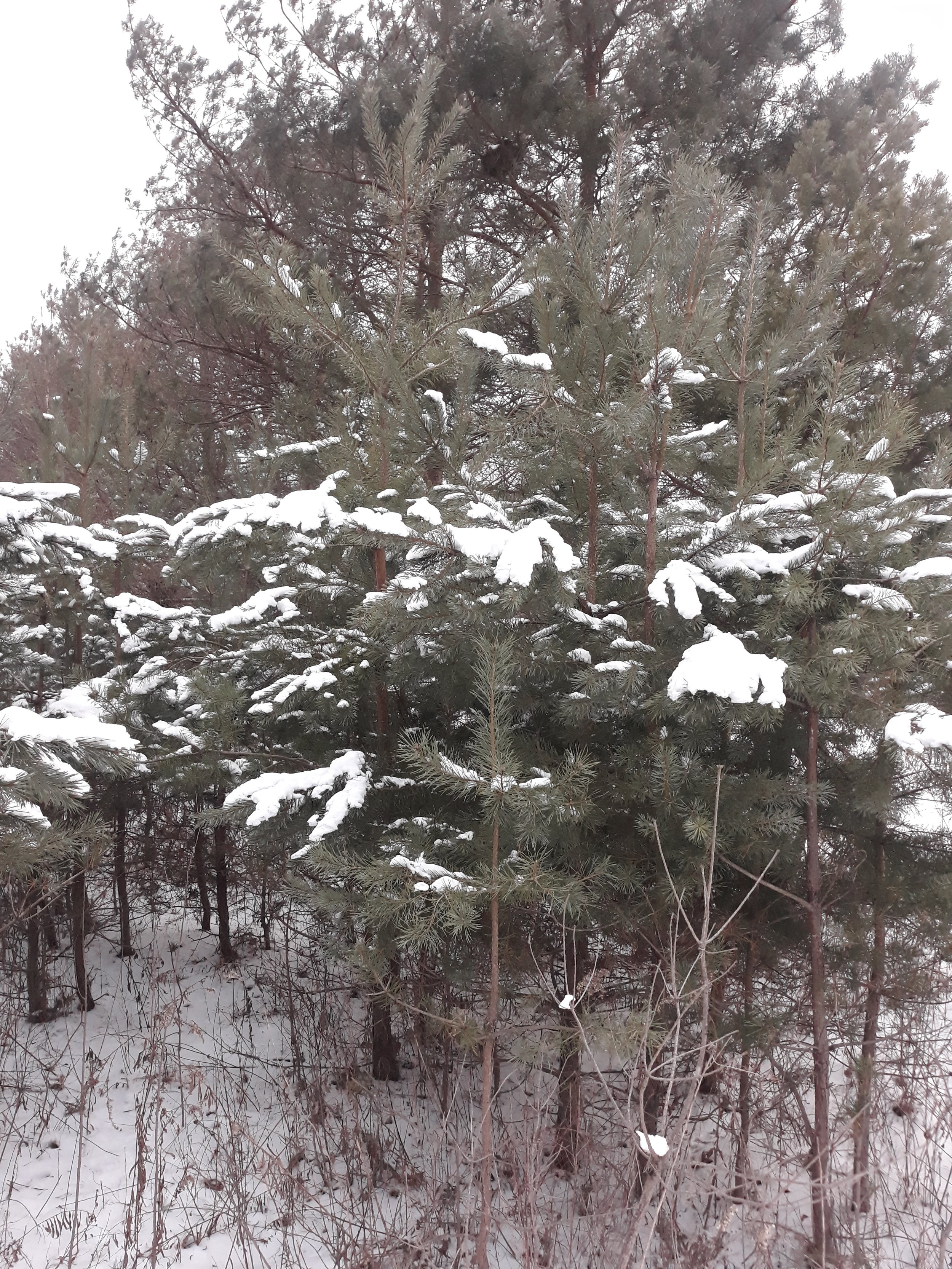Tree Medicine: Pines
A large White Pine towers above the rest of the forest at Lodge Lake. Lupton, MI.
Much ambiguity surrounds the word “pine”, but for our purposes, we are defining a “pine” as any tree belonging to the Pinus genus of the Pinaceae family. The Pinus genus boasts over 100 species, making it the largest family of conifers. Pines are also a favorite of landscapers, as there are 800 cultivars of pine in existence today. This genus inhabits the northern hemisphere in both Eurasia and North America. Pines are long lived and typically live at least hundreds of years under fair conditions, but can live thousands of years! Carbon dating has revealed that some pines will live for thousands of years! Just think, there are Pines alive now which were alive at the beginning of recorded human history! Pines first made their appearance on Mother Earth during the Jurassic period and are well represented in fossil form, helping paleobotanists deduce their origins and evolutionary paths.
Red Pines are easy to spot in the forest due to their characteristic bark which flakes off over the years as the layers below thicken.
The following is the taxonomic classification of pines:
Family: Pinaceae
Subfamily: Pinoideae
Genus: Pinus
Species: Pinus banksiana/resinosa/strobus
In Michigan, large glacial sand deposits have resulted in Pine Barrens habitats in much of the northern parts of the state (the Huron National Forest is a prime example of this). Pines can tolerate these types of sandy, dry, acidic infertile soils better than many other plants, and have taken advantage of the situation. Technically speaking, each species of pine has slightly different chemical constituents, but in the genus, there are several compounds that are found in differing varieties in most pines. The following are the most common chemical constituents occurring across the genus: β-Pinene, Camphene, α-Pinene, Sabinene , 3-Carene, α-Terpineol, Terpinolene, Limonene, Bornyl acetate, Caryophyllene, Phellandrene, and α-Terpinene. These chemical constituents are what give pines their antimicrobial, antifungal, antiparasitic, antiviral, anti-allergenic, antispasmodic, antihyperglycemic, anti-inflammatory and antiviral properties. The use of Pine in medicine dates back to the night of time, and has been used extensively in the treatment of respiratory ailments due to its high vitamin C content and bronco-dilating properties.
White Pine on a clear winter day.
In Michigan we find 3 varieties of native pines, but you have surely seen other non native varieties in yards, gardens and along highways. Here is a list of our three native pine species:
-pinus resinosa (Red Pine)
-pinus strobus (White Pine)
-pinus banksiana (Jack Pine)
And some common introduced pines:
-pinus sylvestris (Scotch Pine)
-pinus nigra (Austrian/Black Pine)
Scotch Pine with a mature cone still attached. Note the two needles per bundle.
Identifying our native pines:
Pines differ from other evergreens by their needles, which are grouped in small bundles called fascicles. The number of needles per bundle varies and is an easy way to start identifying the pines around you. Bark, cone size and habitat are some of the best distinguishing features! Learning the characteristics of each family can be very helpful, this way you can deduce that a tree is indeed a certain genus (and can be used medicinally) and then narrow it down to what species it is based on the distinguishing features of the genus.
A Red Pine cone clinging to its branch. Notice the shaggy bark on the branch below the cone, here you can see where previous needles once resided. After several years needles fall off of the branches, and the newest several years of growth remains.
Red Pine/ Pinus resinosa
Anisinaabemowin: Apakwanagemag (He flakes off/he scalps himself)
Size: Large, 60-100 ft tall, rounded crown (unlike white pine)
Needles: Found in clusters of 2. Longest needles of the native conifers ranging from 7-10cm long. Slender, straight and sharp, silver-green.
Bark: Redish brown to purplish pink. Large stands (or plantations) often glow purple from the color of the bark. Bark is found piled in thin sheets which gradually shed from the trunk as new bark emerges. Shallow fissures in bark. As the latin name indicated, this pine produces copious amounts of resin when injured, resin deposits are found on the trunks covering former injuries.
Habitat: Well drained, dry, acidic soils, rocky outcrops, sand dunes. Does not do well where there is a high water table.
Distribution: Widespread in the Upper Peninsula, and northern Lower Peninsula.
Look Alikes: Austrian/Black Pine (Pinus Nigra), Austrian pines are frequently planted along the highways in Michigan due to their salt tolerance. Needles are very similar to Red Pine, but bark lacks distinctive red pine scales, and tree do not grow quite as tall. Unlike Red Pine, needles do not break when sharply bent.
Red Pine photos below: Photo 1: young red pine branch- needles grow along entire branch when young. Photo 2: A pile of discarded pine at the city compost heap. You can see how over the years the tree loses its needles along the branch and all that remains are several years worth of growth at the end of each branch. Photo 3: Red Pine plantation in pine barrens habitat, surrounded by sweet fern. Photo 4: A mature red pine branch tip with cones still attached beside a bark specimen.
White Pine/Pinus Strobus
Anishinaabemowin: Zhingwaak
Size: Large tree, 60-100 feet tall, growing to large diameter trunk. Pines are the only evergreens which spread their crowns, making them highly susceptible to wind damage. Often growing away from the prevailing winds.
Needles: Found in clusters of 5 needles, 7-12 cm long, flexible, soft and pale green.
Bark: Young trees sport smooth green grey bark. As the tree ages the bark becomes thick, grey-brown and deeply fissured as the layers of bark build up on older trees.
Habitat: One of the most adaptable conifers in our region- found growing in a variety of sites. Generally prefers well drained soil, but is also found occasionally in swamps on mounds.
Distribution: Widespread throughout the state. Abundant in the northern reaches of both peninsulas.
Jack Pine/Pinus banksiana
Anishinaabemowin: Okikaandag “he is crippled with arthritis”
Size: Small to medium, 30-60 feet tall. Form is highly variable and often grow looking gnarled and contorted.
Needles: Found in clusters of 2, short, 2-4 cm long, fascicles are attached directly to the stems on younger trees, instead of at the ends of branches (like White or Red Pine). Color- green-greenish yellow.
Bark: Deep grayish brown. Rough and scaly.
Habitat: Common in Pine Barrens habitats with highly acidic, dry, sandy soil. Often associates with Pin Oak, Red Pine and Sweet Fern. Shade intolerant.
Distribution: Common throughout the Upper Peninsula and the Northern Half of the Lower Peninsula. An important tree/ecosystem for the endangered Kirtland Warbler which breeds nowhere else in the world. Species is fire dependent- needs fire to open cones to release seeds from the scales sealed with resin.
Photos below: Photo 1-2 Young Jack Pine branches with resin coating the growth tips to protect them through the winter until spring arrives. Photo 3: Side view of a young jack pine branch. Photo 4: Jack pine needle up close. Photo 5: Jack pine needle next to a scotch pine needle- the jack pines needles are much smaller. Photo 6: Two jack pine specimens depicting the difference between young and old trees. Older trees sport puffs of needles at the end of contorted branches- the needles you see are several years worth of growth tips.
Scotch/Scots Pine/ Pinus Sylvestris (Non Native)
Size: Medium sized tree, 30-50 feet tall. Variable in form.
Needles: Found in clusters of 2. 5-10cm long. Young trees often have bluish needles- a hue similar to Blue Spruce, as trees age the needles lengthen and appear more silvery than bluish. Needles are often slightly twisted.
Bark: One of the most distinctive features of the Scotch Pine is its bark. On older trees, about halfway up the bark peels off revealing a green to copper colored skin below and thin layers of bark. If you’re not sure whether it is a Scotch Pine or a Jack Pine look up at the top of the tree, if the bark is peeling and coppery it is a Scotch Pine. Bark on lower portion of tree is pale greyish brown.
Habitat: Similar habitat to Red Pine, prefers dry upland soils.
Distribution: Introduced from Europe and now used widely in landscaping or in pine plantations.
Some ways to invite pines into your home:
Tea-
Making a tea is as simple as combining hot water and the evergreen of your choice. How much plant material to use is up to you. Start with a few springs of fresh twigs, or a handful of dry needles. Increase amount of plant material to increase the flavor of the tea- some evergreens taste better brewed into a weak tea, others are hardly detectable unless you use a larger amount. When brewing an evergreen tea, put a saucer or small plate over the top to prevent the volatile oils from evaporating off. Try each evergreen that appeals to you individually before adding it to a blend to see how you like the flavor- many evergreens do not taste exactly as they smell.
Sinus Steam-
Making a sinus or facial steam is one of the quickest ways to enjoy the powers of evergreens-evergreens in the Pinaceae family are rich in pinene which is a bronchodilator, helping to widen airways and relax lung muscles, making it a useful remedy in your home apothecary. Simply place a large handful of evergreens in a large bowl or pan, boil water in a kettle, let cool just slightly and pour over the plant material. When the steam is cool enough to tolerate, lean over steaming bowl, and cover head with a towel to trap steam and inhale. Leftover liquid can be drank as a tea! Adding a few springs of evergreen twigs to a pot of water on the stove is an easy way to humidify the dry winter air of your home while releasing the enchanting fragrance of evergreens.
Tree Medicine Liniment-
A liniment is essentially a tincture for topical use in a base of a volatile solvent that will dissipate upon application leaving the medicine suspended over the skin. These can be used on cuts, scrapes, bruises, stiff and sore areas. These are great to have in your herbal first aid kit for cleaning and promoting healing of topical concerns. Liniments are typically made with witch hazel or rubbing alcohol. Label these well after bottling as you don’t want to accidentally consume it. This recipe is based on plants in our bioregion, but things like chili, ginger,willow bark, menthol crystals and all sorts of other herbs can be used and tailored to the intended application. Herbs should be crumbled into small pieces or powdered for best results. Liniments have an indefinite shelf life.
2 cups rubbing alcohol (isopropyl alcohol 70% or above)
4 T powdered Red Pine Resin
4 T Balsam Poplar Buds- fresh (Balsam poplar, cottonwood, other poplar spp.)
4 T Red Pine Needle
4 T Sweet Fern
4 T Willow bark
4 T White Pine
4 T Yarrow
4 T Plantain
Add all plant material to a jar, cover with rubbing alcohol. Shake daily. Allow to infuse for 4-6 weeks before straining, bottling and labeling. To use, apply to cuts, scrapes, bruises, burns and other acute skin afflictions. If you wish to use a liniment for arthritis, back pain, sprains, sore muscles and more, you may also use witch hazel as the base- this makes a better choice for liniment used on a chronic issue since the witch hazel is less drying than the rubbing alcohol. For use on acute issues the alcohol can be an advantage to help clean a wound and help it dry/seal up quicker.
Resources:
Jolly WM, Hintz J, Linn RL, Kropp RC, Conrad ET, Parsons RA, Winterkamp J. Seasonal variations in red pine (Pinus resinosa) and jack pine (Pinus banksiana) foliar physio-chemistry and their potential influence on stand-scale wildland fire behavior. Forest Ecology and Management. 2016 Aug 1;373:167-78.
H. A. I. MADGWICK, Variations in the Chemical Composition of Red Pine ( Pinus resinosa Ait) Leaves: a Comparison of Well-grown and Poorly grown Trees , Forestry: An International Journal of Forest Research, Volume 37, Issue 1, 1964, Pages 87–94,
Wolter, K.E. and Zinkel, D.F., 1984. Observations on the physiological mechanisms and chemical constituents of induced oleoresin synthesis in Pinus resinosa. Canadian Journal of Forest Research, 14(3), pp.452-458
Pichette, A., Garneau, F.X., Jean, F.I., Riedl, B. and Girard, M., 1998. Chemical differences between the wood extracts of jack pine (Pinus banksiana), black spruce (Picea mariana) and balsam fir (Abies balsamea) from eastern Canada. Journal of wood chemistry and technology, 18(4), pp.427-438.
Kepler, C.B., Irvine, G.W., DeCapita, M.E. and Weinrich, J., 1996. The conservation management of Kirtland's Warbler Dendroica kirtlandii. Bird Conservation International, 6(1), pp.11-22.
Botkin, D.B., Woodby, D.A. and Nisbet, R.A., 1991. Kirtland's warbler habitats: a possible early indicator of climatic warming. Biological Conservation, 56(1), pp.63-78.
Harun, J. and Labosky, P., 1985. Chemical constituents of five northeastern barks. Wood and Fiber science, 17(2), pp.274-280.
Erdtman, H., 1950. The phenolic constituents of Pine heartwood. V. The heartwood of Pinus strobus. The phenolic constituents of Pine heartwood. V. The heartwood of Pinus strobus., (1157 a).
Krauze-Baranowska, M., Mardarowicz, M., Wiwart, M., Pobłocka, L. and Dynowska, M., 2002. Antifungal activity of the essential oils from some species of the genus Pinus. Zeitschrift für Naturforschung C, 57(5-6), pp.478-482.
Mirov, N.T., 1948. The terpenes (in relation to the biology of genus Pinus). Annual review of biochemistry, 17(1), pp.521-540.
Hanover, J.W., 1972. Factors affecting the release of volatile chemicals by forest trees.[Pinius sylvestris; Pinus monticola; Pinus strobus Picea glauca; Picea pungens; Pseudotsuga menziesii; Abies concolor; Pinus nigra; Picea pungens glauca var. Thompson]. Mitt. Forst. Bundesversuchsanst. Wien;(Austria), 97(2).
McMullin, D.R., Green, B.D. and Miller, J.D., 2015. Antifungal sesquiterpenoids and macrolides from an endophytic Lophodermium species of Pinus strobus. Phytochemistry Letters, 14, pp.148-152.
Ioannou, E., Koutsaviti, A., Tzakou, O. and Roussis, V., 2014. The genus Pinus: a comparative study on the needle essential oil composition of 46 pine species. Phytochemistry Reviews, 13(4), pp.741-768.
Little, E.L. and Critchfield, W.B., 1927. Subdivisions of the genus Pinus (pines) (No. 1144). US Department of Agriculture, Forest Service.





